Principles of Financial Management: The Bank of Queensland
VerifiedAdded on 2023/01/05
|24
|4351
|29
AI Summary
This document provides an overview of the principles of financial management applied by the Bank of Queensland. It discusses the Australian financial system, the dominance of major banks, and the role of regulators in the industry. The document also analyzes the bank's financial assets, financial structure, and key ratios important to creditors and shareholders.
Contribute Materials
Your contribution can guide someone’s learning journey. Share your
documents today.
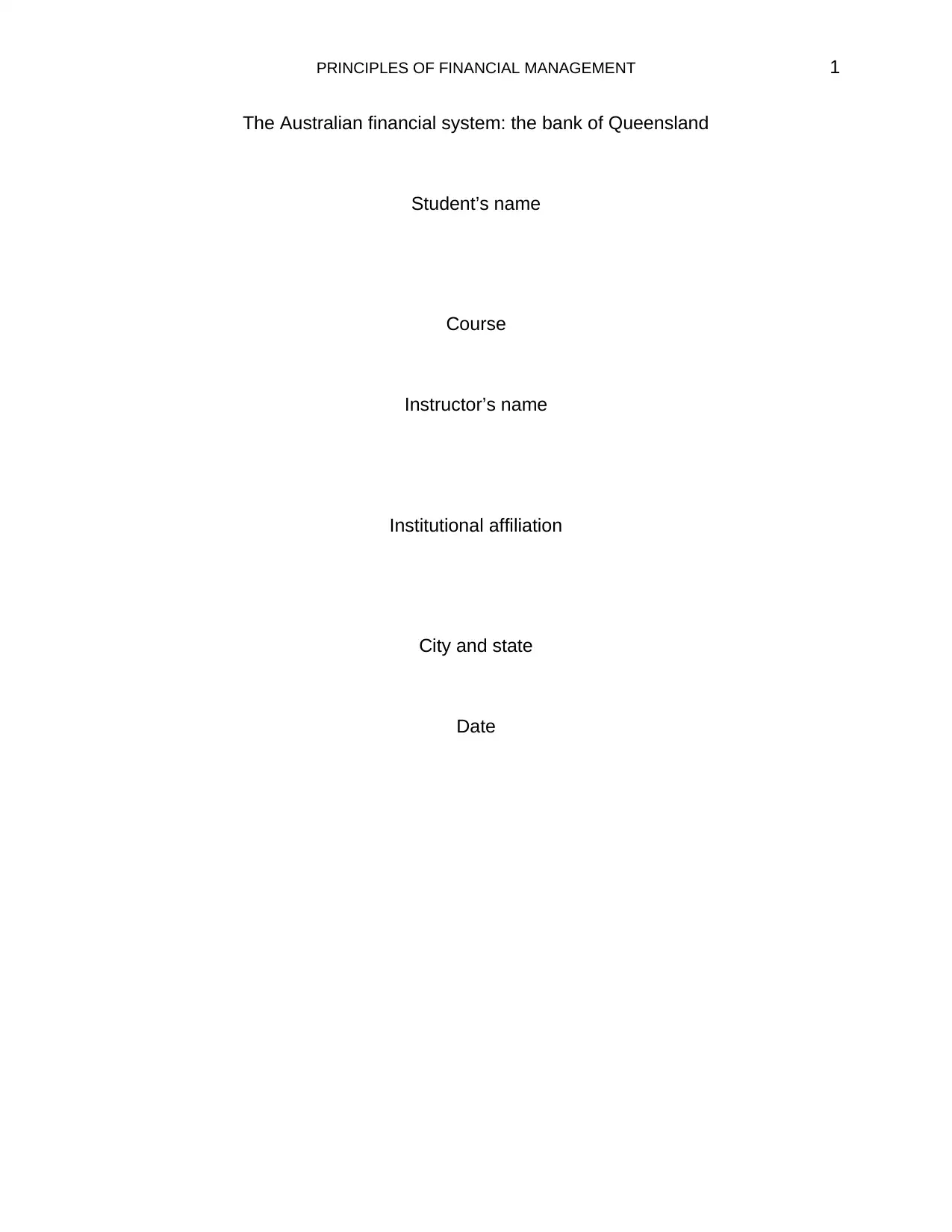
PRINCIPLES OF FINANCIAL MANAGEMENT 1
The Australian financial system: the bank of Queensland
Student’s name
Course
Instructor’s name
Institutional affiliation
City and state
Date
The Australian financial system: the bank of Queensland
Student’s name
Course
Instructor’s name
Institutional affiliation
City and state
Date
Secure Best Marks with AI Grader
Need help grading? Try our AI Grader for instant feedback on your assignments.
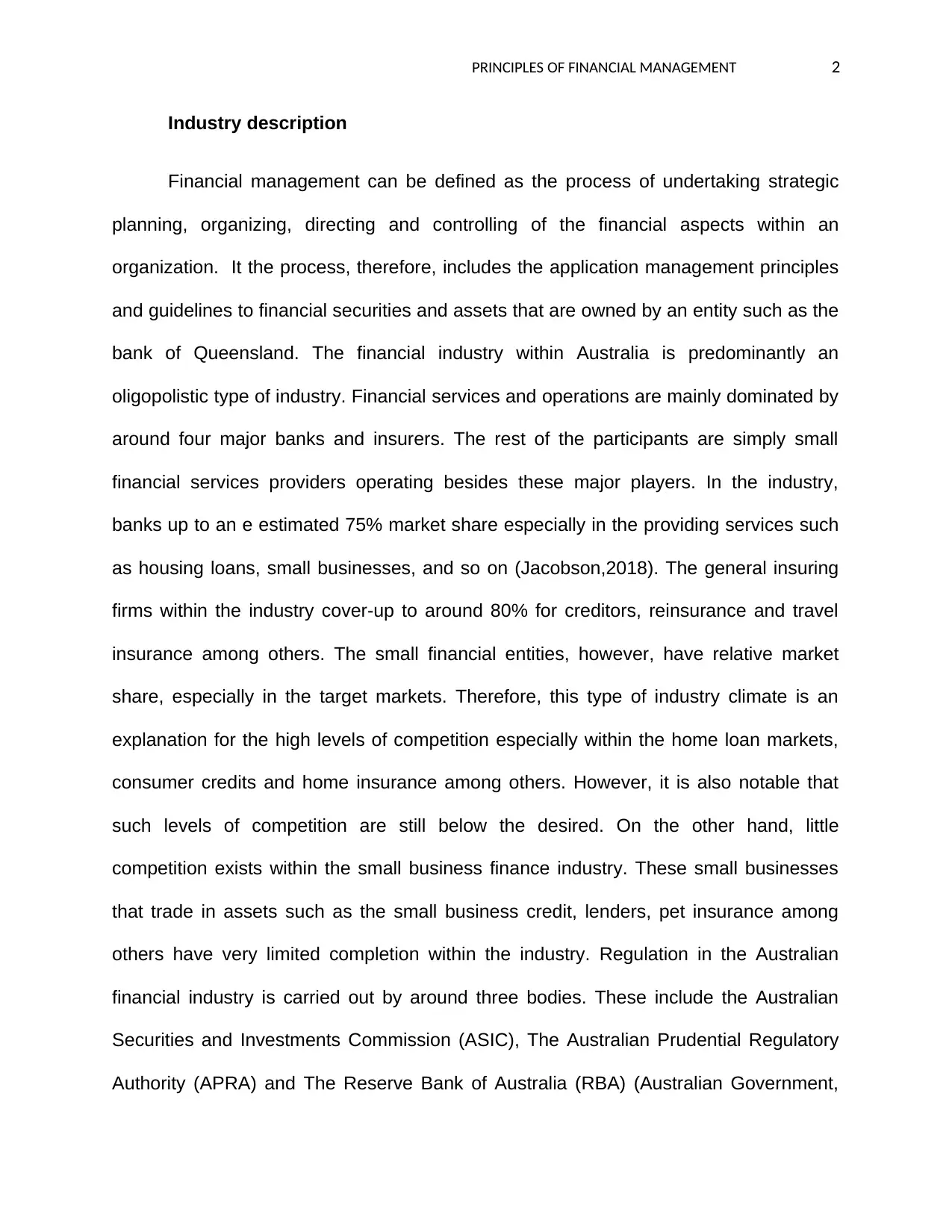
PRINCIPLES OF FINANCIAL MANAGEMENT 2
Industry description
Financial management can be defined as the process of undertaking strategic
planning, organizing, directing and controlling of the financial aspects within an
organization. It the process, therefore, includes the application management principles
and guidelines to financial securities and assets that are owned by an entity such as the
bank of Queensland. The financial industry within Australia is predominantly an
oligopolistic type of industry. Financial services and operations are mainly dominated by
around four major banks and insurers. The rest of the participants are simply small
financial services providers operating besides these major players. In the industry,
banks up to an e estimated 75% market share especially in the providing services such
as housing loans, small businesses, and so on (Jacobson,2018). The general insuring
firms within the industry cover-up to around 80% for creditors, reinsurance and travel
insurance among others. The small financial entities, however, have relative market
share, especially in the target markets. Therefore, this type of industry climate is an
explanation for the high levels of competition especially within the home loan markets,
consumer credits and home insurance among others. However, it is also notable that
such levels of competition are still below the desired. On the other hand, little
competition exists within the small business finance industry. These small businesses
that trade in assets such as the small business credit, lenders, pet insurance among
others have very limited completion within the industry. Regulation in the Australian
financial industry is carried out by around three bodies. These include the Australian
Securities and Investments Commission (ASIC), The Australian Prudential Regulatory
Authority (APRA) and The Reserve Bank of Australia (RBA) (Australian Government,
Industry description
Financial management can be defined as the process of undertaking strategic
planning, organizing, directing and controlling of the financial aspects within an
organization. It the process, therefore, includes the application management principles
and guidelines to financial securities and assets that are owned by an entity such as the
bank of Queensland. The financial industry within Australia is predominantly an
oligopolistic type of industry. Financial services and operations are mainly dominated by
around four major banks and insurers. The rest of the participants are simply small
financial services providers operating besides these major players. In the industry,
banks up to an e estimated 75% market share especially in the providing services such
as housing loans, small businesses, and so on (Jacobson,2018). The general insuring
firms within the industry cover-up to around 80% for creditors, reinsurance and travel
insurance among others. The small financial entities, however, have relative market
share, especially in the target markets. Therefore, this type of industry climate is an
explanation for the high levels of competition especially within the home loan markets,
consumer credits and home insurance among others. However, it is also notable that
such levels of competition are still below the desired. On the other hand, little
competition exists within the small business finance industry. These small businesses
that trade in assets such as the small business credit, lenders, pet insurance among
others have very limited completion within the industry. Regulation in the Australian
financial industry is carried out by around three bodies. These include the Australian
Securities and Investments Commission (ASIC), The Australian Prudential Regulatory
Authority (APRA) and The Reserve Bank of Australia (RBA) (Australian Government,
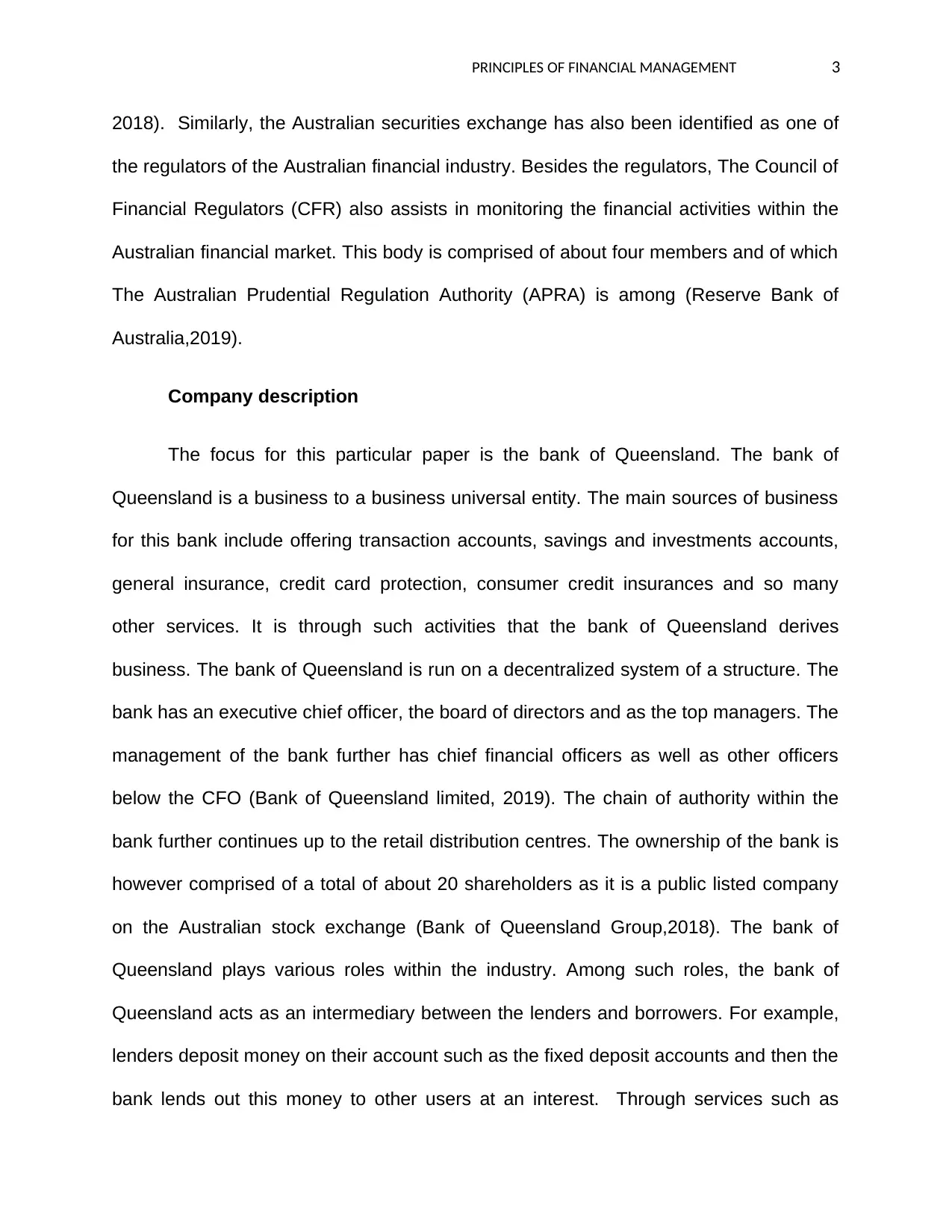
PRINCIPLES OF FINANCIAL MANAGEMENT 3
2018). Similarly, the Australian securities exchange has also been identified as one of
the regulators of the Australian financial industry. Besides the regulators, The Council of
Financial Regulators (CFR) also assists in monitoring the financial activities within the
Australian financial market. This body is comprised of about four members and of which
The Australian Prudential Regulation Authority (APRA) is among (Reserve Bank of
Australia,2019).
Company description
The focus for this particular paper is the bank of Queensland. The bank of
Queensland is a business to a business universal entity. The main sources of business
for this bank include offering transaction accounts, savings and investments accounts,
general insurance, credit card protection, consumer credit insurances and so many
other services. It is through such activities that the bank of Queensland derives
business. The bank of Queensland is run on a decentralized system of a structure. The
bank has an executive chief officer, the board of directors and as the top managers. The
management of the bank further has chief financial officers as well as other officers
below the CFO (Bank of Queensland limited, 2019). The chain of authority within the
bank further continues up to the retail distribution centres. The ownership of the bank is
however comprised of a total of about 20 shareholders as it is a public listed company
on the Australian stock exchange (Bank of Queensland Group,2018). The bank of
Queensland plays various roles within the industry. Among such roles, the bank of
Queensland acts as an intermediary between the lenders and borrowers. For example,
lenders deposit money on their account such as the fixed deposit accounts and then the
bank lends out this money to other users at an interest. Through services such as
2018). Similarly, the Australian securities exchange has also been identified as one of
the regulators of the Australian financial industry. Besides the regulators, The Council of
Financial Regulators (CFR) also assists in monitoring the financial activities within the
Australian financial market. This body is comprised of about four members and of which
The Australian Prudential Regulation Authority (APRA) is among (Reserve Bank of
Australia,2019).
Company description
The focus for this particular paper is the bank of Queensland. The bank of
Queensland is a business to a business universal entity. The main sources of business
for this bank include offering transaction accounts, savings and investments accounts,
general insurance, credit card protection, consumer credit insurances and so many
other services. It is through such activities that the bank of Queensland derives
business. The bank of Queensland is run on a decentralized system of a structure. The
bank has an executive chief officer, the board of directors and as the top managers. The
management of the bank further has chief financial officers as well as other officers
below the CFO (Bank of Queensland limited, 2019). The chain of authority within the
bank further continues up to the retail distribution centres. The ownership of the bank is
however comprised of a total of about 20 shareholders as it is a public listed company
on the Australian stock exchange (Bank of Queensland Group,2018). The bank of
Queensland plays various roles within the industry. Among such roles, the bank of
Queensland acts as an intermediary between the lenders and borrowers. For example,
lenders deposit money on their account such as the fixed deposit accounts and then the
bank lends out this money to other users at an interest. Through services such as
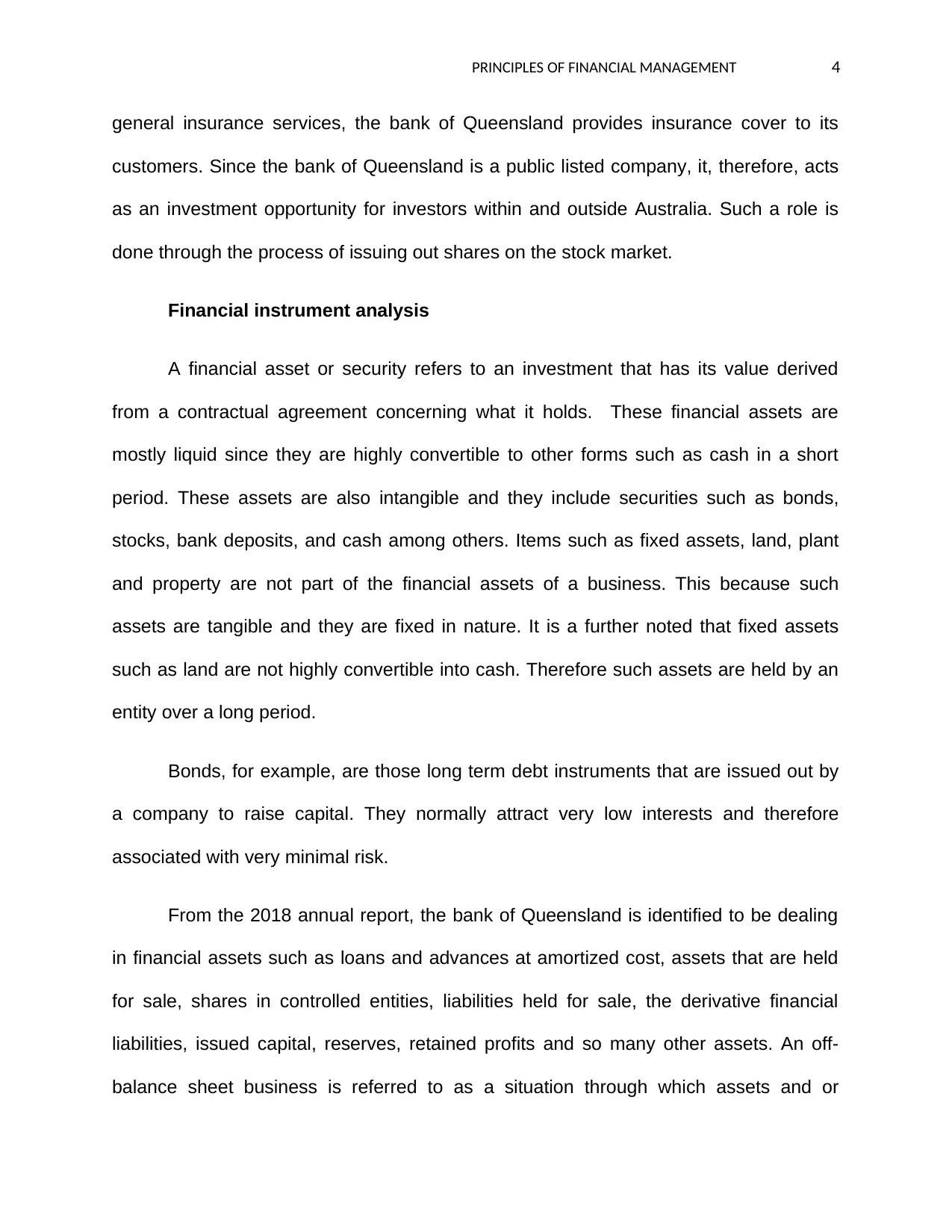
PRINCIPLES OF FINANCIAL MANAGEMENT 4
general insurance services, the bank of Queensland provides insurance cover to its
customers. Since the bank of Queensland is a public listed company, it, therefore, acts
as an investment opportunity for investors within and outside Australia. Such a role is
done through the process of issuing out shares on the stock market.
Financial instrument analysis
A financial asset or security refers to an investment that has its value derived
from a contractual agreement concerning what it holds. These financial assets are
mostly liquid since they are highly convertible to other forms such as cash in a short
period. These assets are also intangible and they include securities such as bonds,
stocks, bank deposits, and cash among others. Items such as fixed assets, land, plant
and property are not part of the financial assets of a business. This because such
assets are tangible and they are fixed in nature. It is a further noted that fixed assets
such as land are not highly convertible into cash. Therefore such assets are held by an
entity over a long period.
Bonds, for example, are those long term debt instruments that are issued out by
a company to raise capital. They normally attract very low interests and therefore
associated with very minimal risk.
From the 2018 annual report, the bank of Queensland is identified to be dealing
in financial assets such as loans and advances at amortized cost, assets that are held
for sale, shares in controlled entities, liabilities held for sale, the derivative financial
liabilities, issued capital, reserves, retained profits and so many other assets. An off-
balance sheet business is referred to as a situation through which assets and or
general insurance services, the bank of Queensland provides insurance cover to its
customers. Since the bank of Queensland is a public listed company, it, therefore, acts
as an investment opportunity for investors within and outside Australia. Such a role is
done through the process of issuing out shares on the stock market.
Financial instrument analysis
A financial asset or security refers to an investment that has its value derived
from a contractual agreement concerning what it holds. These financial assets are
mostly liquid since they are highly convertible to other forms such as cash in a short
period. These assets are also intangible and they include securities such as bonds,
stocks, bank deposits, and cash among others. Items such as fixed assets, land, plant
and property are not part of the financial assets of a business. This because such
assets are tangible and they are fixed in nature. It is a further noted that fixed assets
such as land are not highly convertible into cash. Therefore such assets are held by an
entity over a long period.
Bonds, for example, are those long term debt instruments that are issued out by
a company to raise capital. They normally attract very low interests and therefore
associated with very minimal risk.
From the 2018 annual report, the bank of Queensland is identified to be dealing
in financial assets such as loans and advances at amortized cost, assets that are held
for sale, shares in controlled entities, liabilities held for sale, the derivative financial
liabilities, issued capital, reserves, retained profits and so many other assets. An off-
balance sheet business is referred to as a situation through which assets and or
Secure Best Marks with AI Grader
Need help grading? Try our AI Grader for instant feedback on your assignments.
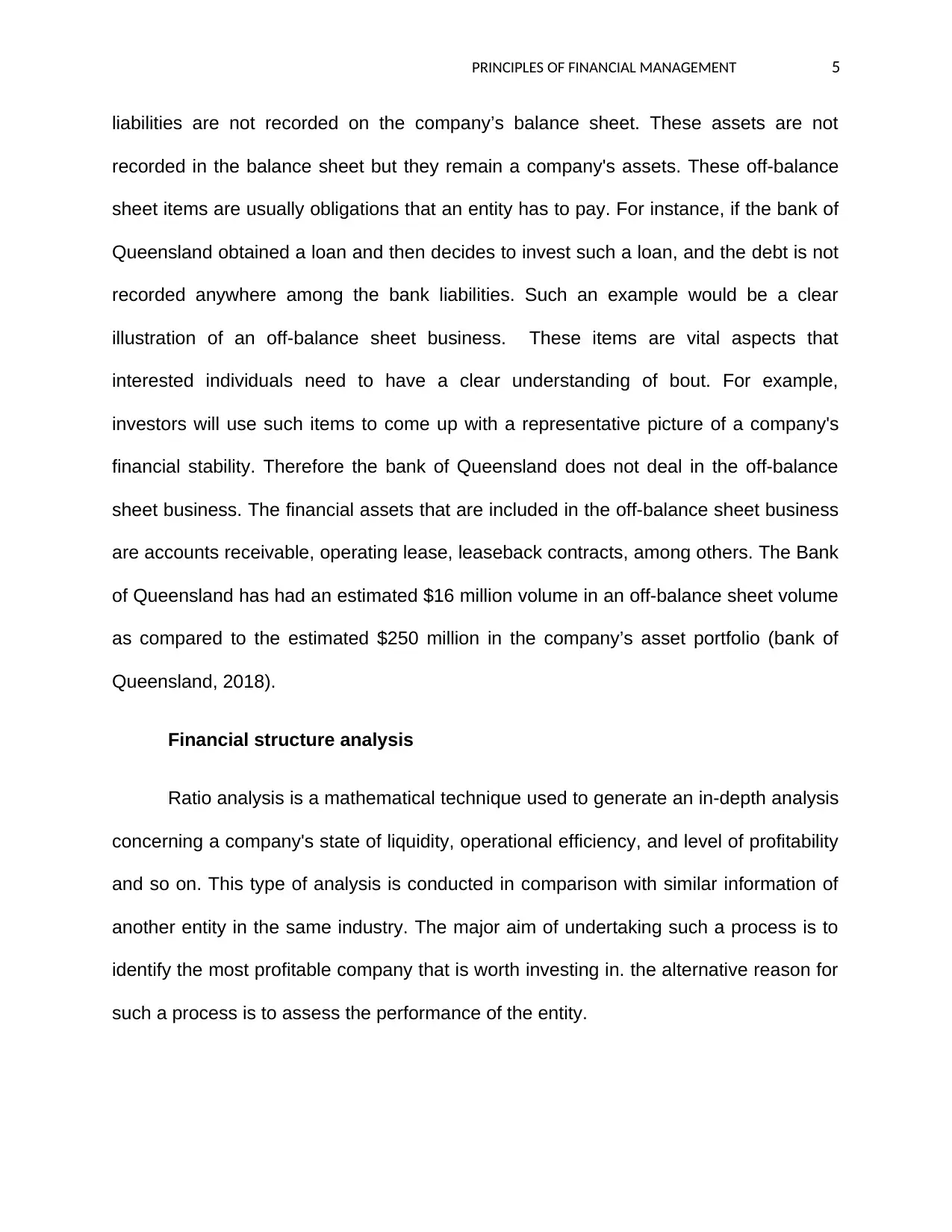
PRINCIPLES OF FINANCIAL MANAGEMENT 5
liabilities are not recorded on the company’s balance sheet. These assets are not
recorded in the balance sheet but they remain a company's assets. These off-balance
sheet items are usually obligations that an entity has to pay. For instance, if the bank of
Queensland obtained a loan and then decides to invest such a loan, and the debt is not
recorded anywhere among the bank liabilities. Such an example would be a clear
illustration of an off-balance sheet business. These items are vital aspects that
interested individuals need to have a clear understanding of bout. For example,
investors will use such items to come up with a representative picture of a company's
financial stability. Therefore the bank of Queensland does not deal in the off-balance
sheet business. The financial assets that are included in the off-balance sheet business
are accounts receivable, operating lease, leaseback contracts, among others. The Bank
of Queensland has had an estimated $16 million volume in an off-balance sheet volume
as compared to the estimated $250 million in the company’s asset portfolio (bank of
Queensland, 2018).
Financial structure analysis
Ratio analysis is a mathematical technique used to generate an in-depth analysis
concerning a company's state of liquidity, operational efficiency, and level of profitability
and so on. This type of analysis is conducted in comparison with similar information of
another entity in the same industry. The major aim of undertaking such a process is to
identify the most profitable company that is worth investing in. the alternative reason for
such a process is to assess the performance of the entity.
liabilities are not recorded on the company’s balance sheet. These assets are not
recorded in the balance sheet but they remain a company's assets. These off-balance
sheet items are usually obligations that an entity has to pay. For instance, if the bank of
Queensland obtained a loan and then decides to invest such a loan, and the debt is not
recorded anywhere among the bank liabilities. Such an example would be a clear
illustration of an off-balance sheet business. These items are vital aspects that
interested individuals need to have a clear understanding of bout. For example,
investors will use such items to come up with a representative picture of a company's
financial stability. Therefore the bank of Queensland does not deal in the off-balance
sheet business. The financial assets that are included in the off-balance sheet business
are accounts receivable, operating lease, leaseback contracts, among others. The Bank
of Queensland has had an estimated $16 million volume in an off-balance sheet volume
as compared to the estimated $250 million in the company’s asset portfolio (bank of
Queensland, 2018).
Financial structure analysis
Ratio analysis is a mathematical technique used to generate an in-depth analysis
concerning a company's state of liquidity, operational efficiency, and level of profitability
and so on. This type of analysis is conducted in comparison with similar information of
another entity in the same industry. The major aim of undertaking such a process is to
identify the most profitable company that is worth investing in. the alternative reason for
such a process is to assess the performance of the entity.
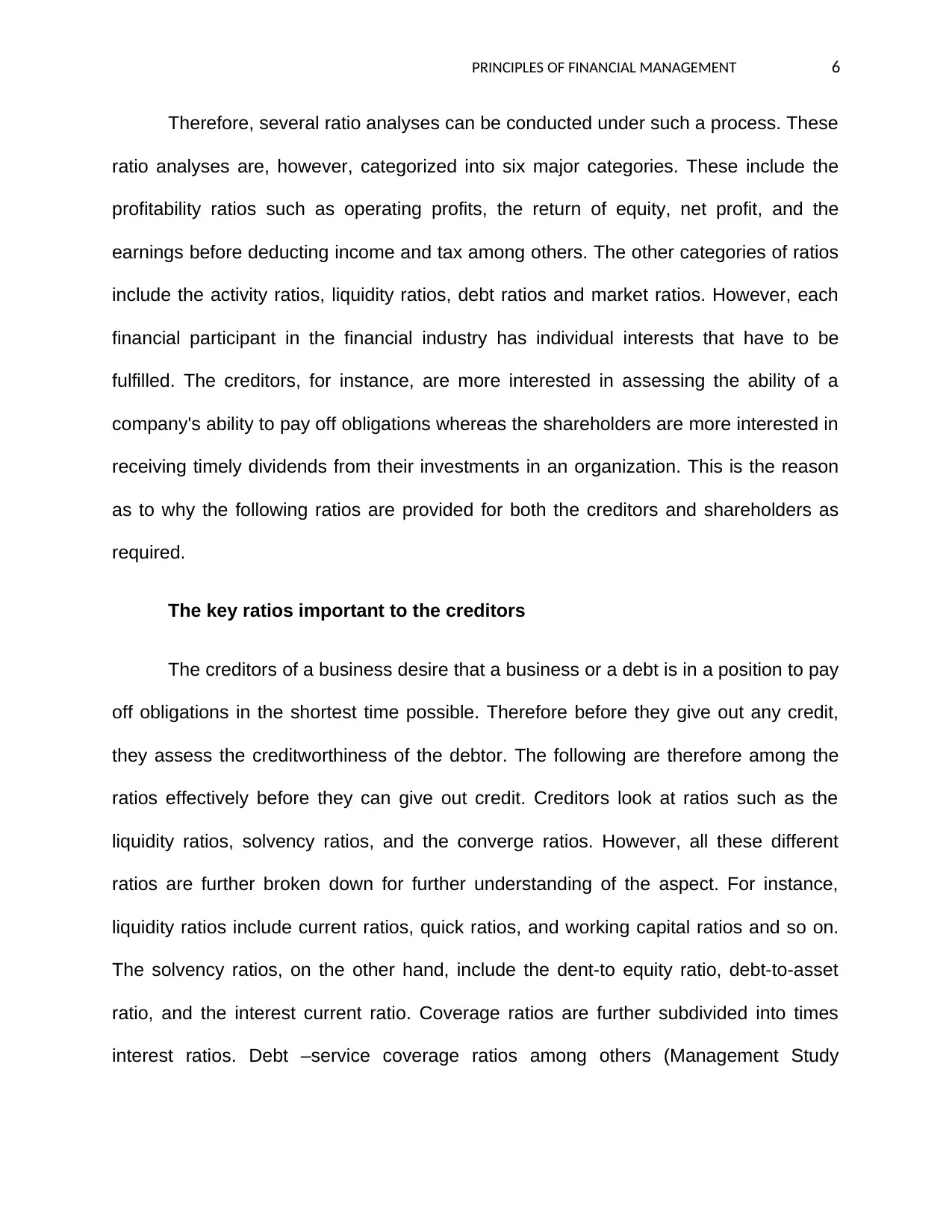
PRINCIPLES OF FINANCIAL MANAGEMENT 6
Therefore, several ratio analyses can be conducted under such a process. These
ratio analyses are, however, categorized into six major categories. These include the
profitability ratios such as operating profits, the return of equity, net profit, and the
earnings before deducting income and tax among others. The other categories of ratios
include the activity ratios, liquidity ratios, debt ratios and market ratios. However, each
financial participant in the financial industry has individual interests that have to be
fulfilled. The creditors, for instance, are more interested in assessing the ability of a
company's ability to pay off obligations whereas the shareholders are more interested in
receiving timely dividends from their investments in an organization. This is the reason
as to why the following ratios are provided for both the creditors and shareholders as
required.
The key ratios important to the creditors
The creditors of a business desire that a business or a debt is in a position to pay
off obligations in the shortest time possible. Therefore before they give out any credit,
they assess the creditworthiness of the debtor. The following are therefore among the
ratios effectively before they can give out credit. Creditors look at ratios such as the
liquidity ratios, solvency ratios, and the converge ratios. However, all these different
ratios are further broken down for further understanding of the aspect. For instance,
liquidity ratios include current ratios, quick ratios, and working capital ratios and so on.
The solvency ratios, on the other hand, include the dent-to equity ratio, debt-to-asset
ratio, and the interest current ratio. Coverage ratios are further subdivided into times
interest ratios. Debt –service coverage ratios among others (Management Study
Therefore, several ratio analyses can be conducted under such a process. These
ratio analyses are, however, categorized into six major categories. These include the
profitability ratios such as operating profits, the return of equity, net profit, and the
earnings before deducting income and tax among others. The other categories of ratios
include the activity ratios, liquidity ratios, debt ratios and market ratios. However, each
financial participant in the financial industry has individual interests that have to be
fulfilled. The creditors, for instance, are more interested in assessing the ability of a
company's ability to pay off obligations whereas the shareholders are more interested in
receiving timely dividends from their investments in an organization. This is the reason
as to why the following ratios are provided for both the creditors and shareholders as
required.
The key ratios important to the creditors
The creditors of a business desire that a business or a debt is in a position to pay
off obligations in the shortest time possible. Therefore before they give out any credit,
they assess the creditworthiness of the debtor. The following are therefore among the
ratios effectively before they can give out credit. Creditors look at ratios such as the
liquidity ratios, solvency ratios, and the converge ratios. However, all these different
ratios are further broken down for further understanding of the aspect. For instance,
liquidity ratios include current ratios, quick ratios, and working capital ratios and so on.
The solvency ratios, on the other hand, include the dent-to equity ratio, debt-to-asset
ratio, and the interest current ratio. Coverage ratios are further subdivided into times
interest ratios. Debt –service coverage ratios among others (Management Study
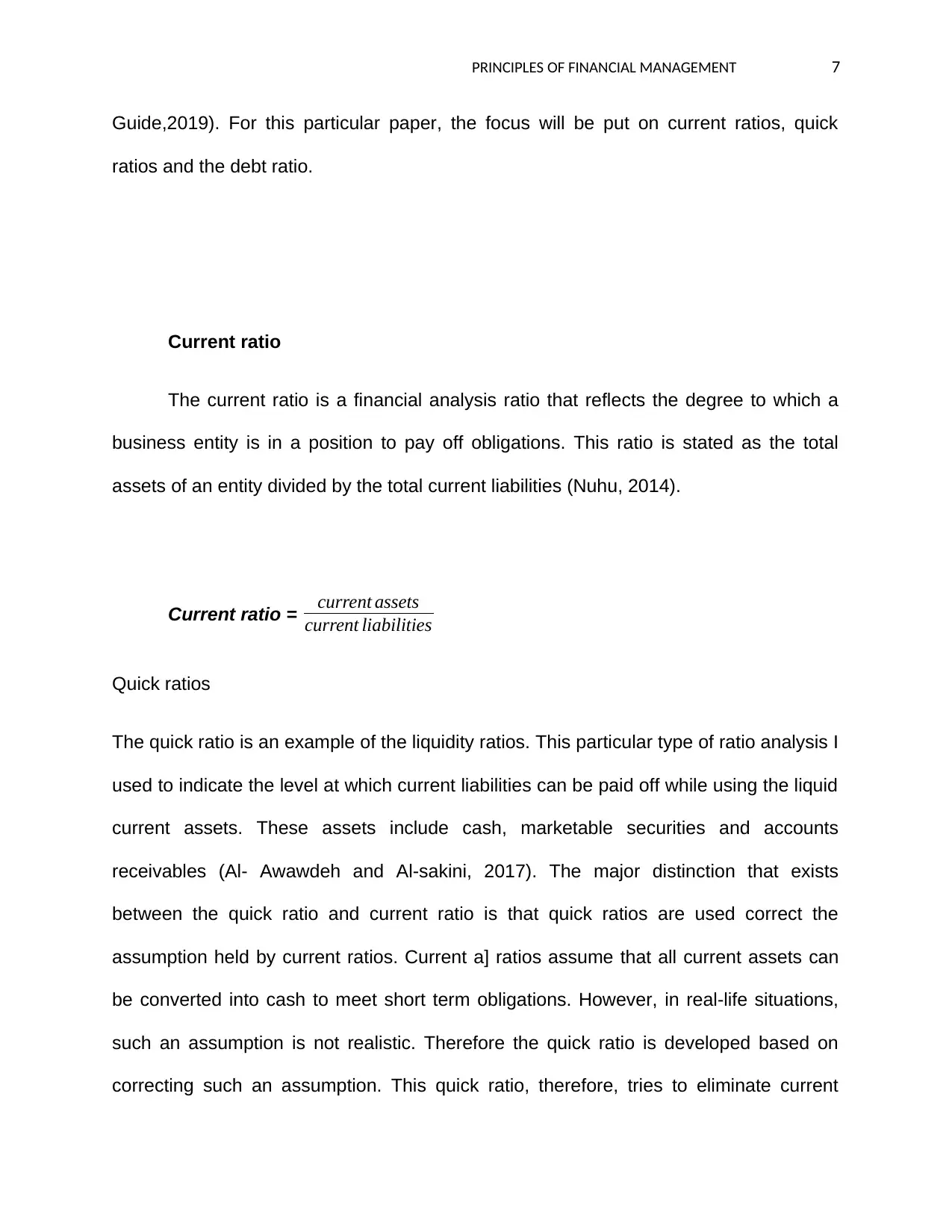
PRINCIPLES OF FINANCIAL MANAGEMENT 7
Guide,2019). For this particular paper, the focus will be put on current ratios, quick
ratios and the debt ratio.
Current ratio
The current ratio is a financial analysis ratio that reflects the degree to which a
business entity is in a position to pay off obligations. This ratio is stated as the total
assets of an entity divided by the total current liabilities (Nuhu, 2014).
Current ratio = current assets
current liabilities
Quick ratios
The quick ratio is an example of the liquidity ratios. This particular type of ratio analysis I
used to indicate the level at which current liabilities can be paid off while using the liquid
current assets. These assets include cash, marketable securities and accounts
receivables (Al- Awawdeh and Al-sakini, 2017). The major distinction that exists
between the quick ratio and current ratio is that quick ratios are used correct the
assumption held by current ratios. Current a] ratios assume that all current assets can
be converted into cash to meet short term obligations. However, in real-life situations,
such an assumption is not realistic. Therefore the quick ratio is developed based on
correcting such an assumption. This quick ratio, therefore, tries to eliminate current
Guide,2019). For this particular paper, the focus will be put on current ratios, quick
ratios and the debt ratio.
Current ratio
The current ratio is a financial analysis ratio that reflects the degree to which a
business entity is in a position to pay off obligations. This ratio is stated as the total
assets of an entity divided by the total current liabilities (Nuhu, 2014).
Current ratio = current assets
current liabilities
Quick ratios
The quick ratio is an example of the liquidity ratios. This particular type of ratio analysis I
used to indicate the level at which current liabilities can be paid off while using the liquid
current assets. These assets include cash, marketable securities and accounts
receivables (Al- Awawdeh and Al-sakini, 2017). The major distinction that exists
between the quick ratio and current ratio is that quick ratios are used correct the
assumption held by current ratios. Current a] ratios assume that all current assets can
be converted into cash to meet short term obligations. However, in real-life situations,
such an assumption is not realistic. Therefore the quick ratio is developed based on
correcting such an assumption. This quick ratio, therefore, tries to eliminate current
Paraphrase This Document
Need a fresh take? Get an instant paraphrase of this document with our AI Paraphraser
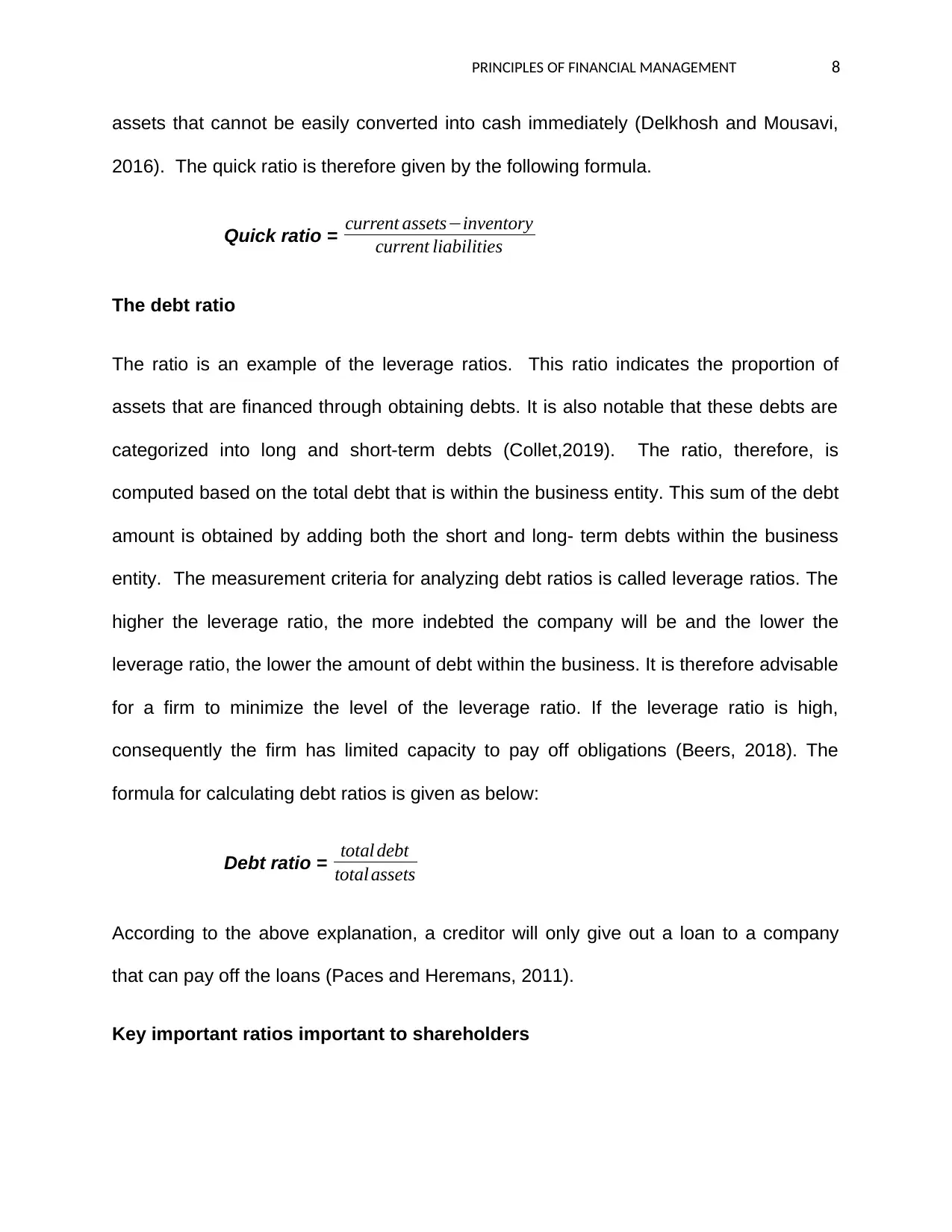
PRINCIPLES OF FINANCIAL MANAGEMENT 8
assets that cannot be easily converted into cash immediately (Delkhosh and Mousavi,
2016). The quick ratio is therefore given by the following formula.
Quick ratio = current assets−inventory
current liabilities
The debt ratio
The ratio is an example of the leverage ratios. This ratio indicates the proportion of
assets that are financed through obtaining debts. It is also notable that these debts are
categorized into long and short-term debts (Collet,2019). The ratio, therefore, is
computed based on the total debt that is within the business entity. This sum of the debt
amount is obtained by adding both the short and long- term debts within the business
entity. The measurement criteria for analyzing debt ratios is called leverage ratios. The
higher the leverage ratio, the more indebted the company will be and the lower the
leverage ratio, the lower the amount of debt within the business. It is therefore advisable
for a firm to minimize the level of the leverage ratio. If the leverage ratio is high,
consequently the firm has limited capacity to pay off obligations (Beers, 2018). The
formula for calculating debt ratios is given as below:
Debt ratio = total debt
total assets
According to the above explanation, a creditor will only give out a loan to a company
that can pay off the loans (Paces and Heremans, 2011).
Key important ratios important to shareholders
assets that cannot be easily converted into cash immediately (Delkhosh and Mousavi,
2016). The quick ratio is therefore given by the following formula.
Quick ratio = current assets−inventory
current liabilities
The debt ratio
The ratio is an example of the leverage ratios. This ratio indicates the proportion of
assets that are financed through obtaining debts. It is also notable that these debts are
categorized into long and short-term debts (Collet,2019). The ratio, therefore, is
computed based on the total debt that is within the business entity. This sum of the debt
amount is obtained by adding both the short and long- term debts within the business
entity. The measurement criteria for analyzing debt ratios is called leverage ratios. The
higher the leverage ratio, the more indebted the company will be and the lower the
leverage ratio, the lower the amount of debt within the business. It is therefore advisable
for a firm to minimize the level of the leverage ratio. If the leverage ratio is high,
consequently the firm has limited capacity to pay off obligations (Beers, 2018). The
formula for calculating debt ratios is given as below:
Debt ratio = total debt
total assets
According to the above explanation, a creditor will only give out a loan to a company
that can pay off the loans (Paces and Heremans, 2011).
Key important ratios important to shareholders
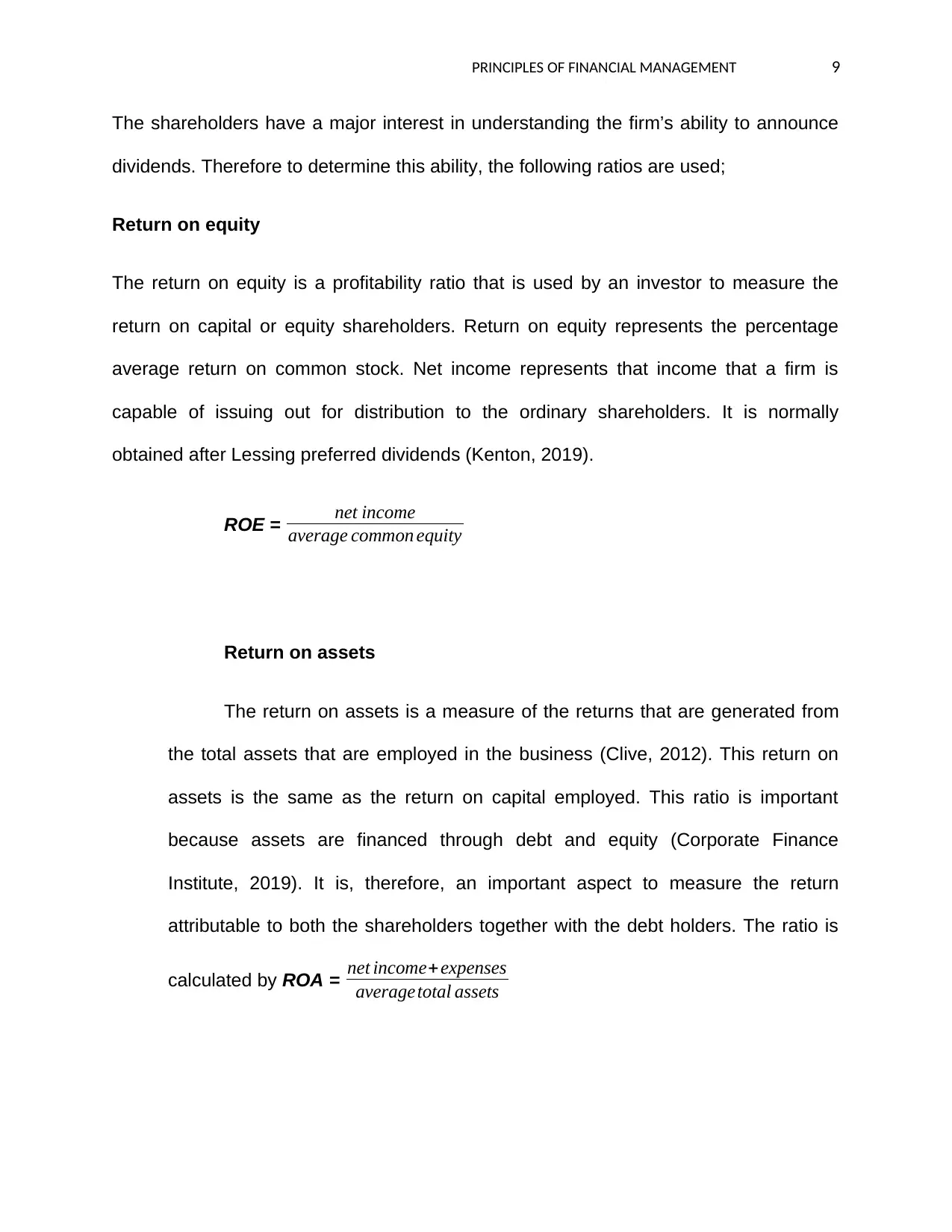
PRINCIPLES OF FINANCIAL MANAGEMENT 9
The shareholders have a major interest in understanding the firm’s ability to announce
dividends. Therefore to determine this ability, the following ratios are used;
Return on equity
The return on equity is a profitability ratio that is used by an investor to measure the
return on capital or equity shareholders. Return on equity represents the percentage
average return on common stock. Net income represents that income that a firm is
capable of issuing out for distribution to the ordinary shareholders. It is normally
obtained after Lessing preferred dividends (Kenton, 2019).
ROE = net income
average common equity
Return on assets
The return on assets is a measure of the returns that are generated from
the total assets that are employed in the business (Clive, 2012). This return on
assets is the same as the return on capital employed. This ratio is important
because assets are financed through debt and equity (Corporate Finance
Institute, 2019). It is, therefore, an important aspect to measure the return
attributable to both the shareholders together with the debt holders. The ratio is
calculated by ROA = net income+expenses
averagetotal assets
The shareholders have a major interest in understanding the firm’s ability to announce
dividends. Therefore to determine this ability, the following ratios are used;
Return on equity
The return on equity is a profitability ratio that is used by an investor to measure the
return on capital or equity shareholders. Return on equity represents the percentage
average return on common stock. Net income represents that income that a firm is
capable of issuing out for distribution to the ordinary shareholders. It is normally
obtained after Lessing preferred dividends (Kenton, 2019).
ROE = net income
average common equity
Return on assets
The return on assets is a measure of the returns that are generated from
the total assets that are employed in the business (Clive, 2012). This return on
assets is the same as the return on capital employed. This ratio is important
because assets are financed through debt and equity (Corporate Finance
Institute, 2019). It is, therefore, an important aspect to measure the return
attributable to both the shareholders together with the debt holders. The ratio is
calculated by ROA = net income+expenses
averagetotal assets
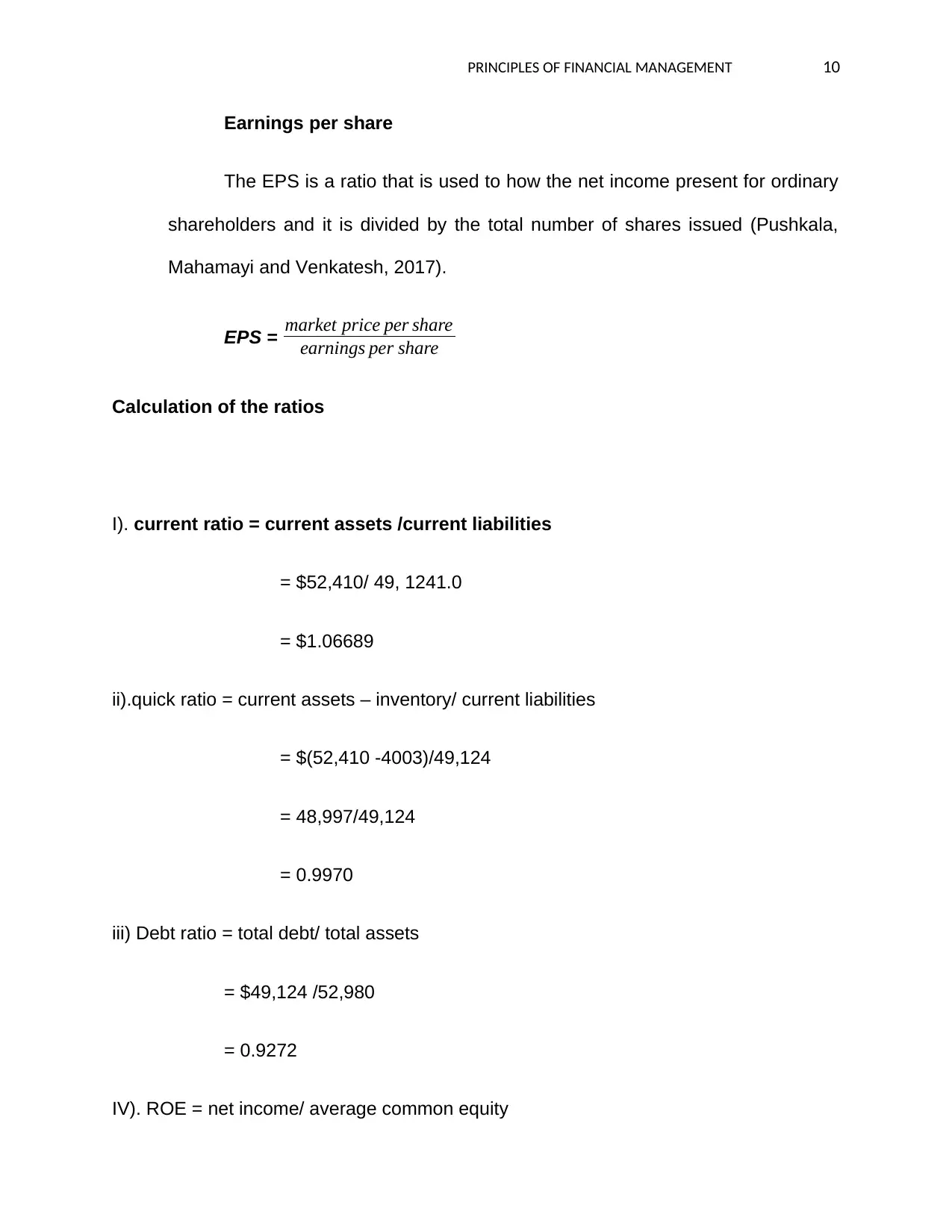
PRINCIPLES OF FINANCIAL MANAGEMENT 10
Earnings per share
The EPS is a ratio that is used to how the net income present for ordinary
shareholders and it is divided by the total number of shares issued (Pushkala,
Mahamayi and Venkatesh, 2017).
EPS = market price per share
earnings per share
Calculation of the ratios
I). current ratio = current assets /current liabilities
= $52,410/ 49, 1241.0
= $1.06689
ii).quick ratio = current assets – inventory/ current liabilities
= $(52,410 -4003)/49,124
= 48,997/49,124
= 0.9970
iii) Debt ratio = total debt/ total assets
= $49,124 /52,980
= 0.9272
IV). ROE = net income/ average common equity
Earnings per share
The EPS is a ratio that is used to how the net income present for ordinary
shareholders and it is divided by the total number of shares issued (Pushkala,
Mahamayi and Venkatesh, 2017).
EPS = market price per share
earnings per share
Calculation of the ratios
I). current ratio = current assets /current liabilities
= $52,410/ 49, 1241.0
= $1.06689
ii).quick ratio = current assets – inventory/ current liabilities
= $(52,410 -4003)/49,124
= 48,997/49,124
= 0.9970
iii) Debt ratio = total debt/ total assets
= $49,124 /52,980
= 0.9272
IV). ROE = net income/ average common equity
Secure Best Marks with AI Grader
Need help grading? Try our AI Grader for instant feedback on your assignments.

PRINCIPLES OF FINANCIAL MANAGEMENT 11
= $339/ (3,856+3360)/2
= 339/ (3,608)
=0.09396 *100
= 9.4%
v). ROA = net income +expenses (average total assets)
= $339+ 1104/(52,980+51658)
= 3391104/104638
= 32.408
VI). EPS = market price per share /earnings per share
= 0.46/166.7
=0.0028
Recommendation on the financing source to use
Depending on the calculated ratios above, it would be a better option for the bank of
Queensland to borrow the ten million AUD instead of issuing out shares on the stock
market. The results generated from the calculations reflect that the bank has a high
capacity to pay off the debts (Caruana,2015). Additionally, the 9.2% leverage ratio
shows that the bank of Queensland has a low debt to equity ratio, therefore, this is an
implication that assets financed by equity outweigh those financed by debt
= $339/ (3,856+3360)/2
= 339/ (3,608)
=0.09396 *100
= 9.4%
v). ROA = net income +expenses (average total assets)
= $339+ 1104/(52,980+51658)
= 3391104/104638
= 32.408
VI). EPS = market price per share /earnings per share
= 0.46/166.7
=0.0028
Recommendation on the financing source to use
Depending on the calculated ratios above, it would be a better option for the bank of
Queensland to borrow the ten million AUD instead of issuing out shares on the stock
market. The results generated from the calculations reflect that the bank has a high
capacity to pay off the debts (Caruana,2015). Additionally, the 9.2% leverage ratio
shows that the bank of Queensland has a low debt to equity ratio, therefore, this is an
implication that assets financed by equity outweigh those financed by debt
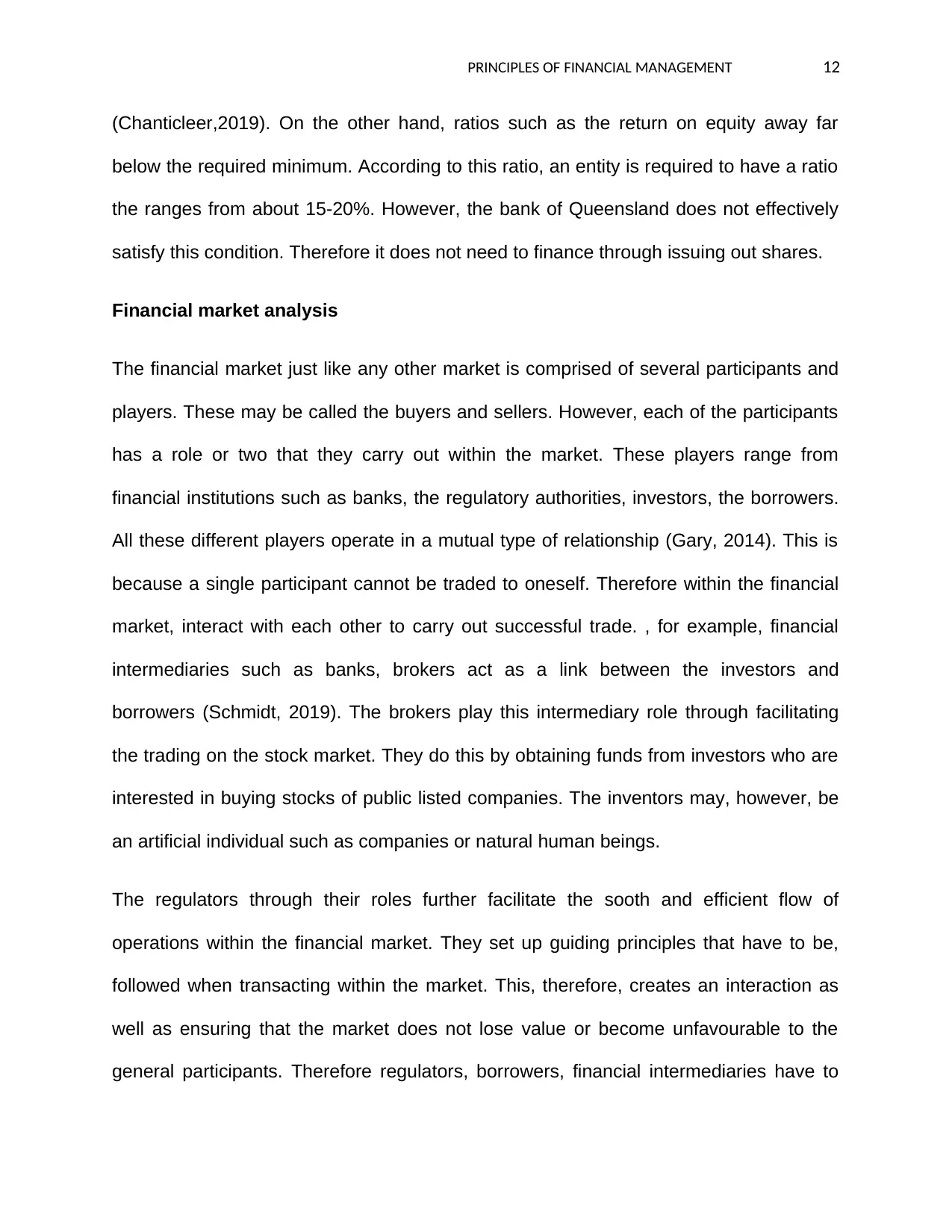
PRINCIPLES OF FINANCIAL MANAGEMENT 12
(Chanticleer,2019). On the other hand, ratios such as the return on equity away far
below the required minimum. According to this ratio, an entity is required to have a ratio
the ranges from about 15-20%. However, the bank of Queensland does not effectively
satisfy this condition. Therefore it does not need to finance through issuing out shares.
Financial market analysis
The financial market just like any other market is comprised of several participants and
players. These may be called the buyers and sellers. However, each of the participants
has a role or two that they carry out within the market. These players range from
financial institutions such as banks, the regulatory authorities, investors, the borrowers.
All these different players operate in a mutual type of relationship (Gary, 2014). This is
because a single participant cannot be traded to oneself. Therefore within the financial
market, interact with each other to carry out successful trade. , for example, financial
intermediaries such as banks, brokers act as a link between the investors and
borrowers (Schmidt, 2019). The brokers play this intermediary role through facilitating
the trading on the stock market. They do this by obtaining funds from investors who are
interested in buying stocks of public listed companies. The inventors may, however, be
an artificial individual such as companies or natural human beings.
The regulators through their roles further facilitate the sooth and efficient flow of
operations within the financial market. They set up guiding principles that have to be,
followed when transacting within the market. This, therefore, creates an interaction as
well as ensuring that the market does not lose value or become unfavourable to the
general participants. Therefore regulators, borrowers, financial intermediaries have to
(Chanticleer,2019). On the other hand, ratios such as the return on equity away far
below the required minimum. According to this ratio, an entity is required to have a ratio
the ranges from about 15-20%. However, the bank of Queensland does not effectively
satisfy this condition. Therefore it does not need to finance through issuing out shares.
Financial market analysis
The financial market just like any other market is comprised of several participants and
players. These may be called the buyers and sellers. However, each of the participants
has a role or two that they carry out within the market. These players range from
financial institutions such as banks, the regulatory authorities, investors, the borrowers.
All these different players operate in a mutual type of relationship (Gary, 2014). This is
because a single participant cannot be traded to oneself. Therefore within the financial
market, interact with each other to carry out successful trade. , for example, financial
intermediaries such as banks, brokers act as a link between the investors and
borrowers (Schmidt, 2019). The brokers play this intermediary role through facilitating
the trading on the stock market. They do this by obtaining funds from investors who are
interested in buying stocks of public listed companies. The inventors may, however, be
an artificial individual such as companies or natural human beings.
The regulators through their roles further facilitate the sooth and efficient flow of
operations within the financial market. They set up guiding principles that have to be,
followed when transacting within the market. This, therefore, creates an interaction as
well as ensuring that the market does not lose value or become unfavourable to the
general participants. Therefore regulators, borrowers, financial intermediaries have to
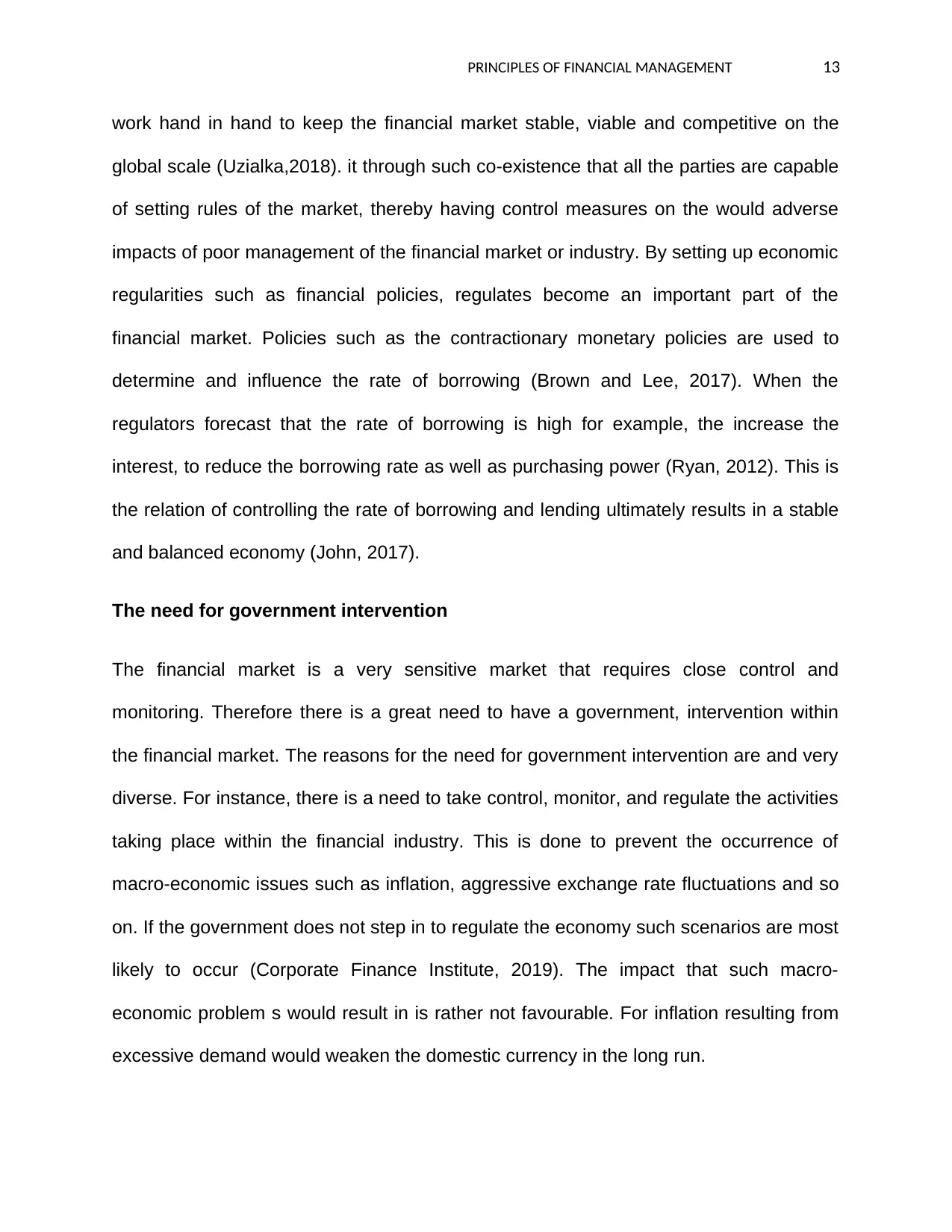
PRINCIPLES OF FINANCIAL MANAGEMENT 13
work hand in hand to keep the financial market stable, viable and competitive on the
global scale (Uzialka,2018). it through such co-existence that all the parties are capable
of setting rules of the market, thereby having control measures on the would adverse
impacts of poor management of the financial market or industry. By setting up economic
regularities such as financial policies, regulates become an important part of the
financial market. Policies such as the contractionary monetary policies are used to
determine and influence the rate of borrowing (Brown and Lee, 2017). When the
regulators forecast that the rate of borrowing is high for example, the increase the
interest, to reduce the borrowing rate as well as purchasing power (Ryan, 2012). This is
the relation of controlling the rate of borrowing and lending ultimately results in a stable
and balanced economy (John, 2017).
The need for government intervention
The financial market is a very sensitive market that requires close control and
monitoring. Therefore there is a great need to have a government, intervention within
the financial market. The reasons for the need for government intervention are and very
diverse. For instance, there is a need to take control, monitor, and regulate the activities
taking place within the financial industry. This is done to prevent the occurrence of
macro-economic issues such as inflation, aggressive exchange rate fluctuations and so
on. If the government does not step in to regulate the economy such scenarios are most
likely to occur (Corporate Finance Institute, 2019). The impact that such macro-
economic problem s would result in is rather not favourable. For inflation resulting from
excessive demand would weaken the domestic currency in the long run.
work hand in hand to keep the financial market stable, viable and competitive on the
global scale (Uzialka,2018). it through such co-existence that all the parties are capable
of setting rules of the market, thereby having control measures on the would adverse
impacts of poor management of the financial market or industry. By setting up economic
regularities such as financial policies, regulates become an important part of the
financial market. Policies such as the contractionary monetary policies are used to
determine and influence the rate of borrowing (Brown and Lee, 2017). When the
regulators forecast that the rate of borrowing is high for example, the increase the
interest, to reduce the borrowing rate as well as purchasing power (Ryan, 2012). This is
the relation of controlling the rate of borrowing and lending ultimately results in a stable
and balanced economy (John, 2017).
The need for government intervention
The financial market is a very sensitive market that requires close control and
monitoring. Therefore there is a great need to have a government, intervention within
the financial market. The reasons for the need for government intervention are and very
diverse. For instance, there is a need to take control, monitor, and regulate the activities
taking place within the financial industry. This is done to prevent the occurrence of
macro-economic issues such as inflation, aggressive exchange rate fluctuations and so
on. If the government does not step in to regulate the economy such scenarios are most
likely to occur (Corporate Finance Institute, 2019). The impact that such macro-
economic problem s would result in is rather not favourable. For inflation resulting from
excessive demand would weaken the domestic currency in the long run.
Paraphrase This Document
Need a fresh take? Get an instant paraphrase of this document with our AI Paraphraser
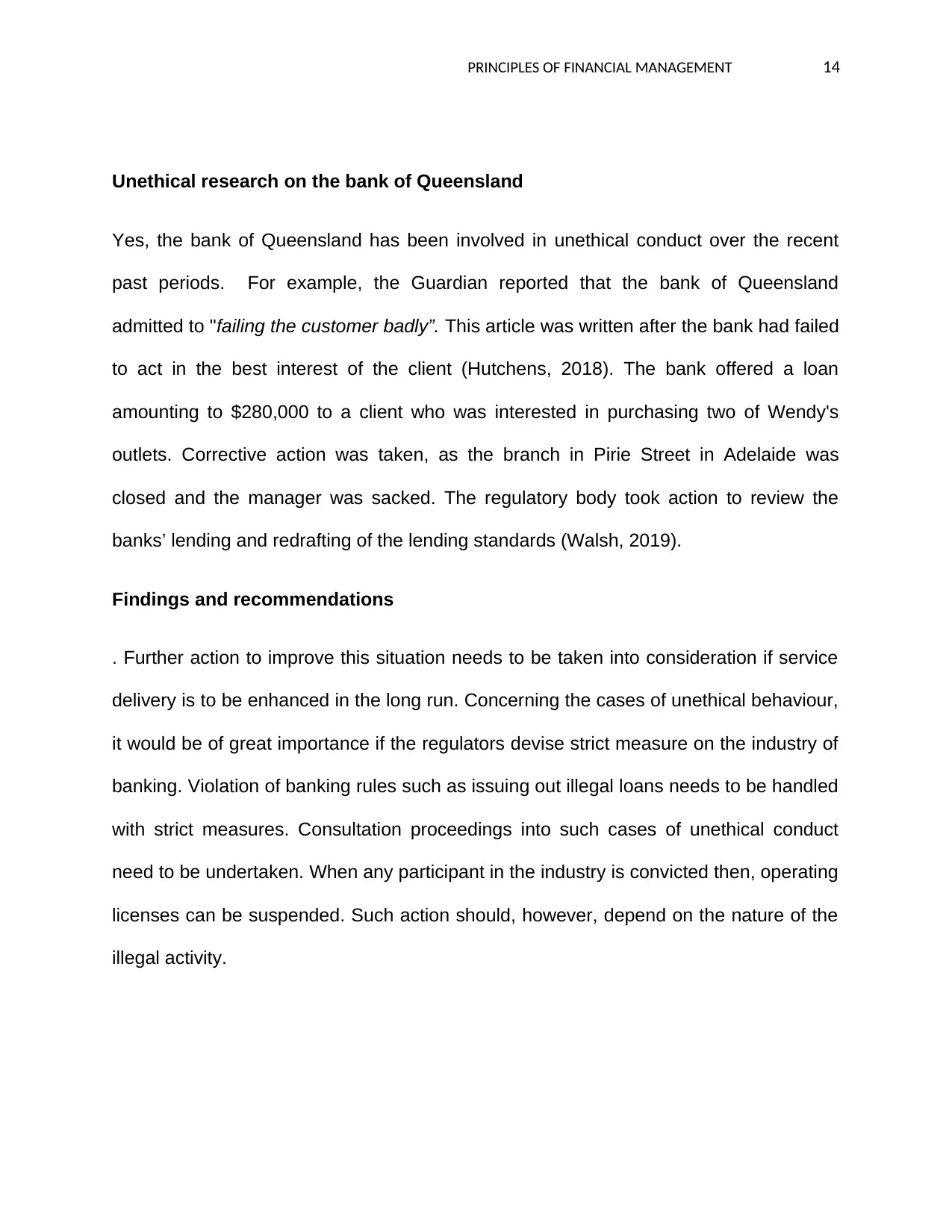
PRINCIPLES OF FINANCIAL MANAGEMENT 14
Unethical research on the bank of Queensland
Yes, the bank of Queensland has been involved in unethical conduct over the recent
past periods. For example, the Guardian reported that the bank of Queensland
admitted to "failing the customer badly”. This article was written after the bank had failed
to act in the best interest of the client (Hutchens, 2018). The bank offered a loan
amounting to $280,000 to a client who was interested in purchasing two of Wendy's
outlets. Corrective action was taken, as the branch in Pirie Street in Adelaide was
closed and the manager was sacked. The regulatory body took action to review the
banks’ lending and redrafting of the lending standards (Walsh, 2019).
Findings and recommendations
. Further action to improve this situation needs to be taken into consideration if service
delivery is to be enhanced in the long run. Concerning the cases of unethical behaviour,
it would be of great importance if the regulators devise strict measure on the industry of
banking. Violation of banking rules such as issuing out illegal loans needs to be handled
with strict measures. Consultation proceedings into such cases of unethical conduct
need to be undertaken. When any participant in the industry is convicted then, operating
licenses can be suspended. Such action should, however, depend on the nature of the
illegal activity.
Unethical research on the bank of Queensland
Yes, the bank of Queensland has been involved in unethical conduct over the recent
past periods. For example, the Guardian reported that the bank of Queensland
admitted to "failing the customer badly”. This article was written after the bank had failed
to act in the best interest of the client (Hutchens, 2018). The bank offered a loan
amounting to $280,000 to a client who was interested in purchasing two of Wendy's
outlets. Corrective action was taken, as the branch in Pirie Street in Adelaide was
closed and the manager was sacked. The regulatory body took action to review the
banks’ lending and redrafting of the lending standards (Walsh, 2019).
Findings and recommendations
. Further action to improve this situation needs to be taken into consideration if service
delivery is to be enhanced in the long run. Concerning the cases of unethical behaviour,
it would be of great importance if the regulators devise strict measure on the industry of
banking. Violation of banking rules such as issuing out illegal loans needs to be handled
with strict measures. Consultation proceedings into such cases of unethical conduct
need to be undertaken. When any participant in the industry is convicted then, operating
licenses can be suspended. Such action should, however, depend on the nature of the
illegal activity.
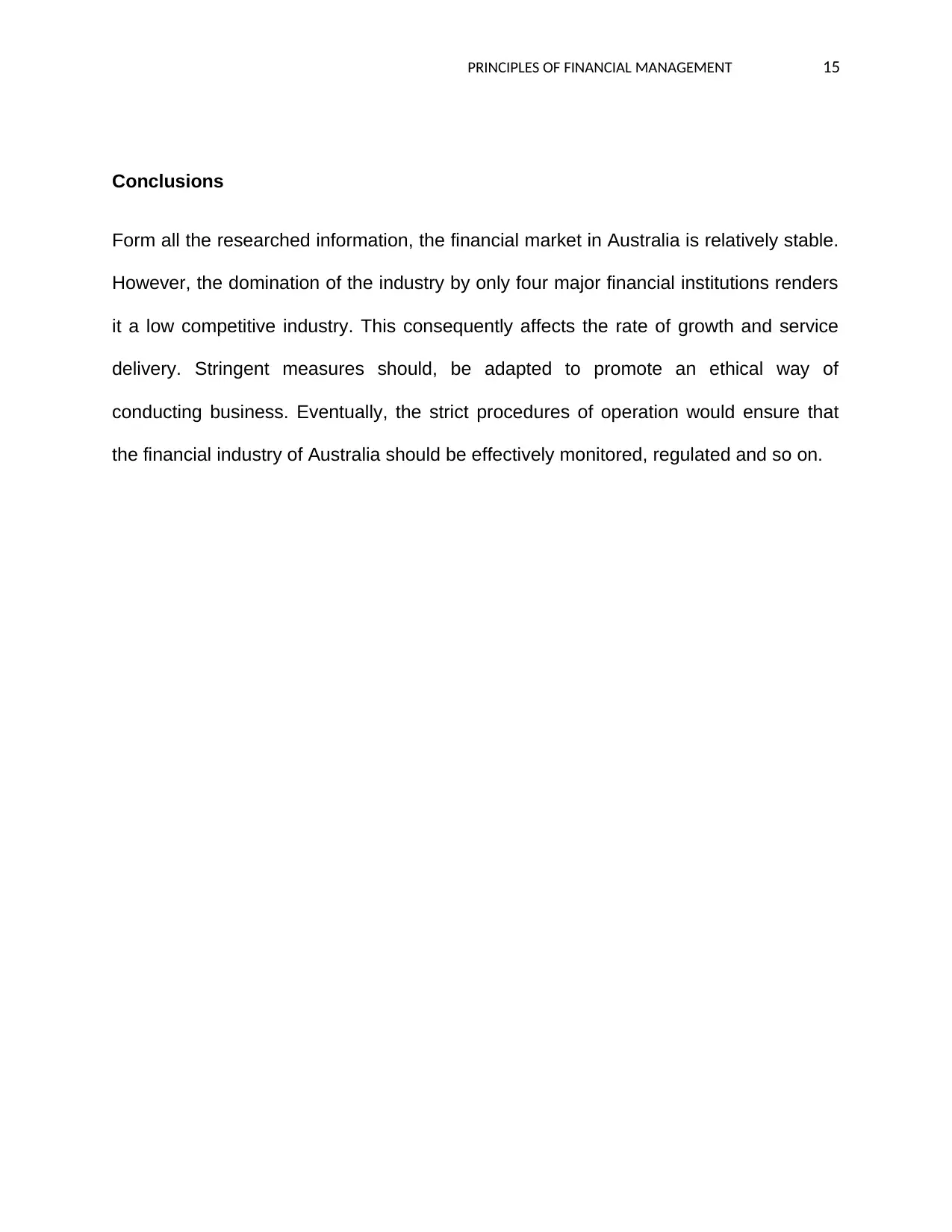
PRINCIPLES OF FINANCIAL MANAGEMENT 15
Conclusions
Form all the researched information, the financial market in Australia is relatively stable.
However, the domination of the industry by only four major financial institutions renders
it a low competitive industry. This consequently affects the rate of growth and service
delivery. Stringent measures should, be adapted to promote an ethical way of
conducting business. Eventually, the strict procedures of operation would ensure that
the financial industry of Australia should be effectively monitored, regulated and so on.
Conclusions
Form all the researched information, the financial market in Australia is relatively stable.
However, the domination of the industry by only four major financial institutions renders
it a low competitive industry. This consequently affects the rate of growth and service
delivery. Stringent measures should, be adapted to promote an ethical way of
conducting business. Eventually, the strict procedures of operation would ensure that
the financial industry of Australia should be effectively monitored, regulated and so on.

PRINCIPLES OF FINANCIAL MANAGEMENT 16
References
Al- Awawdeh. H., Al-Sakini, S. 2017. Off-Balance Items and Their Impact on the
Financial Performance Standards of the Banks: An Empirical Study on the Commercial
Banks Of Jordan: International Business and Management. Retrieved from
http://www.cscanada.net/index.php/ibm/article/download/9993/pdf
Australian Government: Productivity Commission, 2018. Competition in the Australian
Financial System: Productivity Commission Inquiry Report, Overview and
Recommendations. Retrieved from https://www.pc.gov.au/inquiries/completed/financial-
system/report/financial-system-overview.pdf
Bank of Queensland Group, 2018. 2018 Annual Report. Retrieved from
https://www.boq.com.au/content/dam/boq/files/shareholder-centre/financial-results/
2018/FY2018_Annual_Report.pdf
Bank Of Queensland Limited, 2019. Financial Services Guide: Personal Solutions.
Retrieved from https://www.boq.com.au/content/dam/boq/files/terms-and-conditions/
boq-financial-services-guide.pdf
Bank of Queensland, 2018. BOQ Annual Reporting 2018. Retrieved from
https://www.boq.com.au/microsites/annual-reports/2018
Beers B, 2018. What Are Some Types Of off-Balance Sheet Assets? Retrieved from
https://www.investopedia.com/ask/answers/062915/what-types-assets-may-be-
considered-balance-sheet-obs.asp
References
Al- Awawdeh. H., Al-Sakini, S. 2017. Off-Balance Items and Their Impact on the
Financial Performance Standards of the Banks: An Empirical Study on the Commercial
Banks Of Jordan: International Business and Management. Retrieved from
http://www.cscanada.net/index.php/ibm/article/download/9993/pdf
Australian Government: Productivity Commission, 2018. Competition in the Australian
Financial System: Productivity Commission Inquiry Report, Overview and
Recommendations. Retrieved from https://www.pc.gov.au/inquiries/completed/financial-
system/report/financial-system-overview.pdf
Bank of Queensland Group, 2018. 2018 Annual Report. Retrieved from
https://www.boq.com.au/content/dam/boq/files/shareholder-centre/financial-results/
2018/FY2018_Annual_Report.pdf
Bank Of Queensland Limited, 2019. Financial Services Guide: Personal Solutions.
Retrieved from https://www.boq.com.au/content/dam/boq/files/terms-and-conditions/
boq-financial-services-guide.pdf
Bank of Queensland, 2018. BOQ Annual Reporting 2018. Retrieved from
https://www.boq.com.au/microsites/annual-reports/2018
Beers B, 2018. What Are Some Types Of off-Balance Sheet Assets? Retrieved from
https://www.investopedia.com/ask/answers/062915/what-types-assets-may-be-
considered-balance-sheet-obs.asp
Secure Best Marks with AI Grader
Need help grading? Try our AI Grader for instant feedback on your assignments.
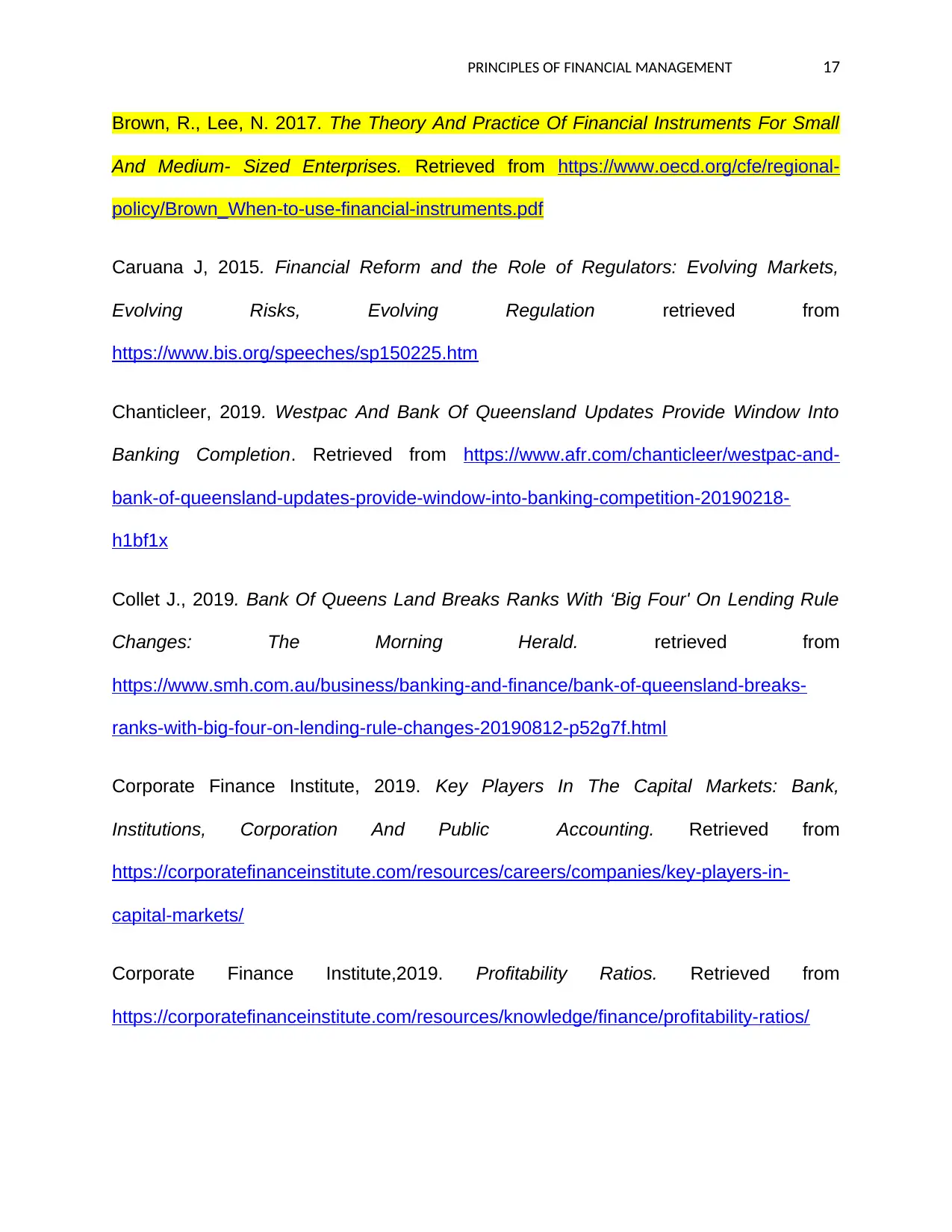
PRINCIPLES OF FINANCIAL MANAGEMENT 17
Brown, R., Lee, N. 2017. The Theory And Practice Of Financial Instruments For Small
And Medium- Sized Enterprises. Retrieved from https://www.oecd.org/cfe/regional-
policy/Brown_When-to-use-financial-instruments.pdf
Caruana J, 2015. Financial Reform and the Role of Regulators: Evolving Markets,
Evolving Risks, Evolving Regulation retrieved from
https://www.bis.org/speeches/sp150225.htm
Chanticleer, 2019. Westpac And Bank Of Queensland Updates Provide Window Into
Banking Completion. Retrieved from https://www.afr.com/chanticleer/westpac-and-
bank-of-queensland-updates-provide-window-into-banking-competition-20190218-
h1bf1x
Collet J., 2019. Bank Of Queens Land Breaks Ranks With ‘Big Four' On Lending Rule
Changes: The Morning Herald. retrieved from
https://www.smh.com.au/business/banking-and-finance/bank-of-queensland-breaks-
ranks-with-big-four-on-lending-rule-changes-20190812-p52g7f.html
Corporate Finance Institute, 2019. Key Players In The Capital Markets: Bank,
Institutions, Corporation And Public Accounting. Retrieved from
https://corporatefinanceinstitute.com/resources/careers/companies/key-players-in-
capital-markets/
Corporate Finance Institute,2019. Profitability Ratios. Retrieved from
https://corporatefinanceinstitute.com/resources/knowledge/finance/profitability-ratios/
Brown, R., Lee, N. 2017. The Theory And Practice Of Financial Instruments For Small
And Medium- Sized Enterprises. Retrieved from https://www.oecd.org/cfe/regional-
policy/Brown_When-to-use-financial-instruments.pdf
Caruana J, 2015. Financial Reform and the Role of Regulators: Evolving Markets,
Evolving Risks, Evolving Regulation retrieved from
https://www.bis.org/speeches/sp150225.htm
Chanticleer, 2019. Westpac And Bank Of Queensland Updates Provide Window Into
Banking Completion. Retrieved from https://www.afr.com/chanticleer/westpac-and-
bank-of-queensland-updates-provide-window-into-banking-competition-20190218-
h1bf1x
Collet J., 2019. Bank Of Queens Land Breaks Ranks With ‘Big Four' On Lending Rule
Changes: The Morning Herald. retrieved from
https://www.smh.com.au/business/banking-and-finance/bank-of-queensland-breaks-
ranks-with-big-four-on-lending-rule-changes-20190812-p52g7f.html
Corporate Finance Institute, 2019. Key Players In The Capital Markets: Bank,
Institutions, Corporation And Public Accounting. Retrieved from
https://corporatefinanceinstitute.com/resources/careers/companies/key-players-in-
capital-markets/
Corporate Finance Institute,2019. Profitability Ratios. Retrieved from
https://corporatefinanceinstitute.com/resources/knowledge/finance/profitability-ratios/
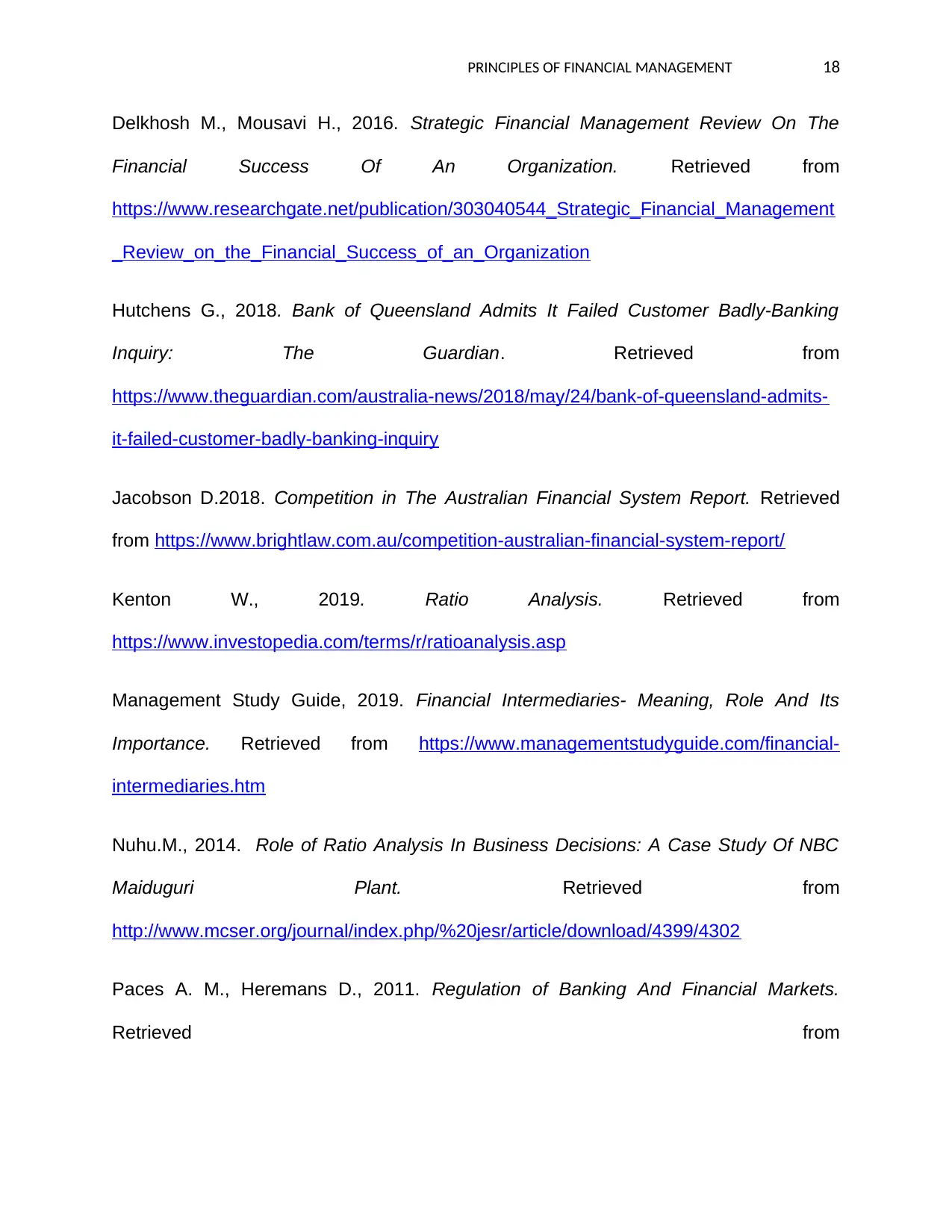
PRINCIPLES OF FINANCIAL MANAGEMENT 18
Delkhosh M., Mousavi H., 2016. Strategic Financial Management Review On The
Financial Success Of An Organization. Retrieved from
https://www.researchgate.net/publication/303040544_Strategic_Financial_Management
_Review_on_the_Financial_Success_of_an_Organization
Hutchens G., 2018. Bank of Queensland Admits It Failed Customer Badly-Banking
Inquiry: The Guardian. Retrieved from
https://www.theguardian.com/australia-news/2018/may/24/bank-of-queensland-admits-
it-failed-customer-badly-banking-inquiry
Jacobson D.2018. Competition in The Australian Financial System Report. Retrieved
from https://www.brightlaw.com.au/competition-australian-financial-system-report/
Kenton W., 2019. Ratio Analysis. Retrieved from
https://www.investopedia.com/terms/r/ratioanalysis.asp
Management Study Guide, 2019. Financial Intermediaries- Meaning, Role And Its
Importance. Retrieved from https://www.managementstudyguide.com/financial-
intermediaries.htm
Nuhu.M., 2014. Role of Ratio Analysis In Business Decisions: A Case Study Of NBC
Maiduguri Plant. Retrieved from
http://www.mcser.org/journal/index.php/%20jesr/article/download/4399/4302
Paces A. M., Heremans D., 2011. Regulation of Banking And Financial Markets.
Retrieved from
Delkhosh M., Mousavi H., 2016. Strategic Financial Management Review On The
Financial Success Of An Organization. Retrieved from
https://www.researchgate.net/publication/303040544_Strategic_Financial_Management
_Review_on_the_Financial_Success_of_an_Organization
Hutchens G., 2018. Bank of Queensland Admits It Failed Customer Badly-Banking
Inquiry: The Guardian. Retrieved from
https://www.theguardian.com/australia-news/2018/may/24/bank-of-queensland-admits-
it-failed-customer-badly-banking-inquiry
Jacobson D.2018. Competition in The Australian Financial System Report. Retrieved
from https://www.brightlaw.com.au/competition-australian-financial-system-report/
Kenton W., 2019. Ratio Analysis. Retrieved from
https://www.investopedia.com/terms/r/ratioanalysis.asp
Management Study Guide, 2019. Financial Intermediaries- Meaning, Role And Its
Importance. Retrieved from https://www.managementstudyguide.com/financial-
intermediaries.htm
Nuhu.M., 2014. Role of Ratio Analysis In Business Decisions: A Case Study Of NBC
Maiduguri Plant. Retrieved from
http://www.mcser.org/journal/index.php/%20jesr/article/download/4399/4302
Paces A. M., Heremans D., 2011. Regulation of Banking And Financial Markets.
Retrieved from
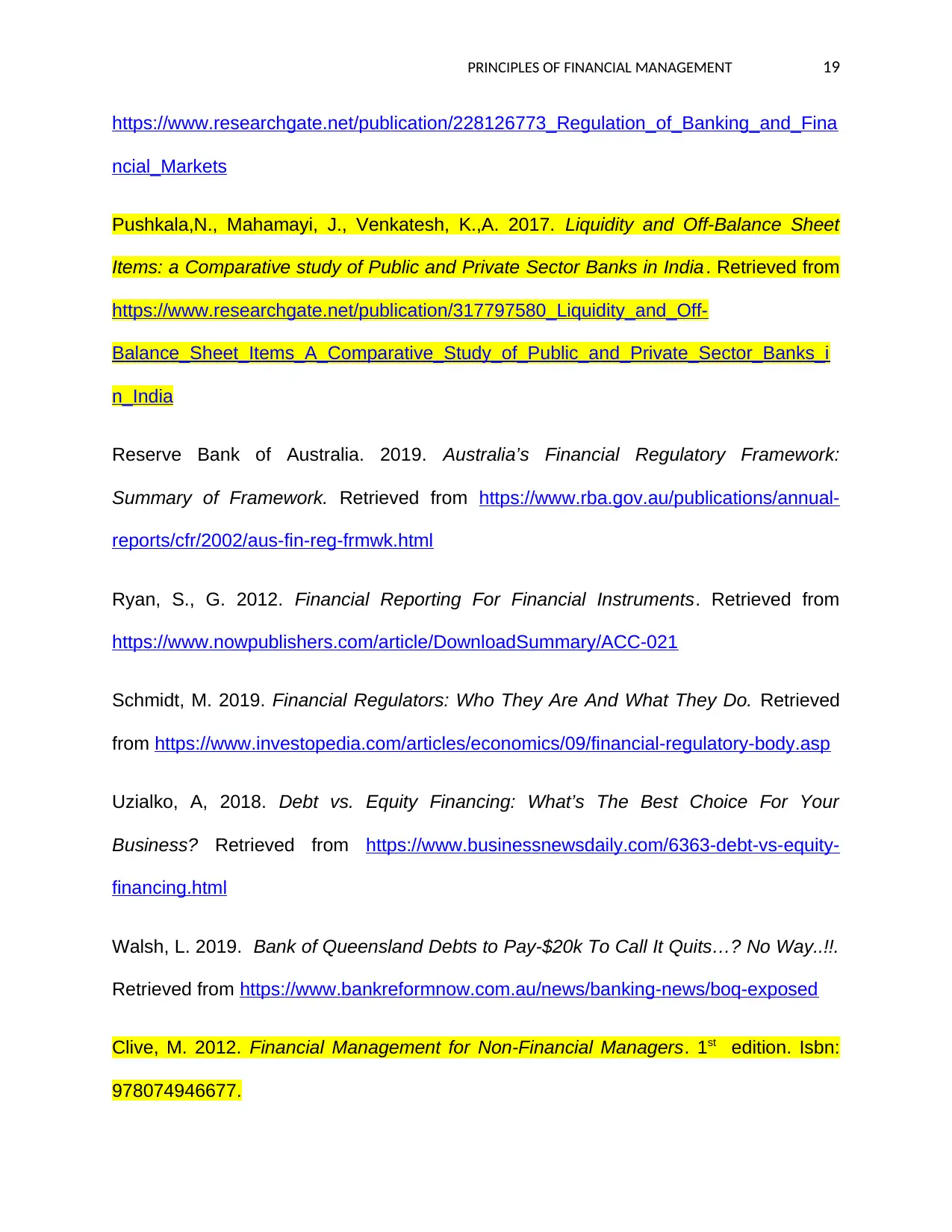
PRINCIPLES OF FINANCIAL MANAGEMENT 19
https://www.researchgate.net/publication/228126773_Regulation_of_Banking_and_Fina
ncial_Markets
Pushkala,N., Mahamayi, J., Venkatesh, K.,A. 2017. Liquidity and Off-Balance Sheet
Items: a Comparative study of Public and Private Sector Banks in India . Retrieved from
https://www.researchgate.net/publication/317797580_Liquidity_and_Off-
Balance_Sheet_Items_A_Comparative_Study_of_Public_and_Private_Sector_Banks_i
n_India
Reserve Bank of Australia. 2019. Australia’s Financial Regulatory Framework:
Summary of Framework. Retrieved from https://www.rba.gov.au/publications/annual-
reports/cfr/2002/aus-fin-reg-frmwk.html
Ryan, S., G. 2012. Financial Reporting For Financial Instruments. Retrieved from
https://www.nowpublishers.com/article/DownloadSummary/ACC-021
Schmidt, M. 2019. Financial Regulators: Who They Are And What They Do. Retrieved
from https://www.investopedia.com/articles/economics/09/financial-regulatory-body.asp
Uzialko, A, 2018. Debt vs. Equity Financing: What’s The Best Choice For Your
Business? Retrieved from https://www.businessnewsdaily.com/6363-debt-vs-equity-
financing.html
Walsh, L. 2019. Bank of Queensland Debts to Pay-$20k To Call It Quits…? No Way..!!.
Retrieved from https://www.bankreformnow.com.au/news/banking-news/boq-exposed
Clive, M. 2012. Financial Management for Non-Financial Managers. 1st edition. Isbn:
978074946677.
https://www.researchgate.net/publication/228126773_Regulation_of_Banking_and_Fina
ncial_Markets
Pushkala,N., Mahamayi, J., Venkatesh, K.,A. 2017. Liquidity and Off-Balance Sheet
Items: a Comparative study of Public and Private Sector Banks in India . Retrieved from
https://www.researchgate.net/publication/317797580_Liquidity_and_Off-
Balance_Sheet_Items_A_Comparative_Study_of_Public_and_Private_Sector_Banks_i
n_India
Reserve Bank of Australia. 2019. Australia’s Financial Regulatory Framework:
Summary of Framework. Retrieved from https://www.rba.gov.au/publications/annual-
reports/cfr/2002/aus-fin-reg-frmwk.html
Ryan, S., G. 2012. Financial Reporting For Financial Instruments. Retrieved from
https://www.nowpublishers.com/article/DownloadSummary/ACC-021
Schmidt, M. 2019. Financial Regulators: Who They Are And What They Do. Retrieved
from https://www.investopedia.com/articles/economics/09/financial-regulatory-body.asp
Uzialko, A, 2018. Debt vs. Equity Financing: What’s The Best Choice For Your
Business? Retrieved from https://www.businessnewsdaily.com/6363-debt-vs-equity-
financing.html
Walsh, L. 2019. Bank of Queensland Debts to Pay-$20k To Call It Quits…? No Way..!!.
Retrieved from https://www.bankreformnow.com.au/news/banking-news/boq-exposed
Clive, M. 2012. Financial Management for Non-Financial Managers. 1st edition. Isbn:
978074946677.
Paraphrase This Document
Need a fresh take? Get an instant paraphrase of this document with our AI Paraphraser

PRINCIPLES OF FINANCIAL MANAGEMENT 20
Gary, B. 2014. Financial Management And Accounting In The Public Sector. 2nd edition,
isbn:9781138787872.
John, P., W. 2017.Financial Management FIN211 (Custom Edition), 2nd edition, isbn:
9781488618420.
Gary, B. 2014. Financial Management And Accounting In The Public Sector. 2nd edition,
isbn:9781138787872.
John, P., W. 2017.Financial Management FIN211 (Custom Edition), 2nd edition, isbn:
9781488618420.
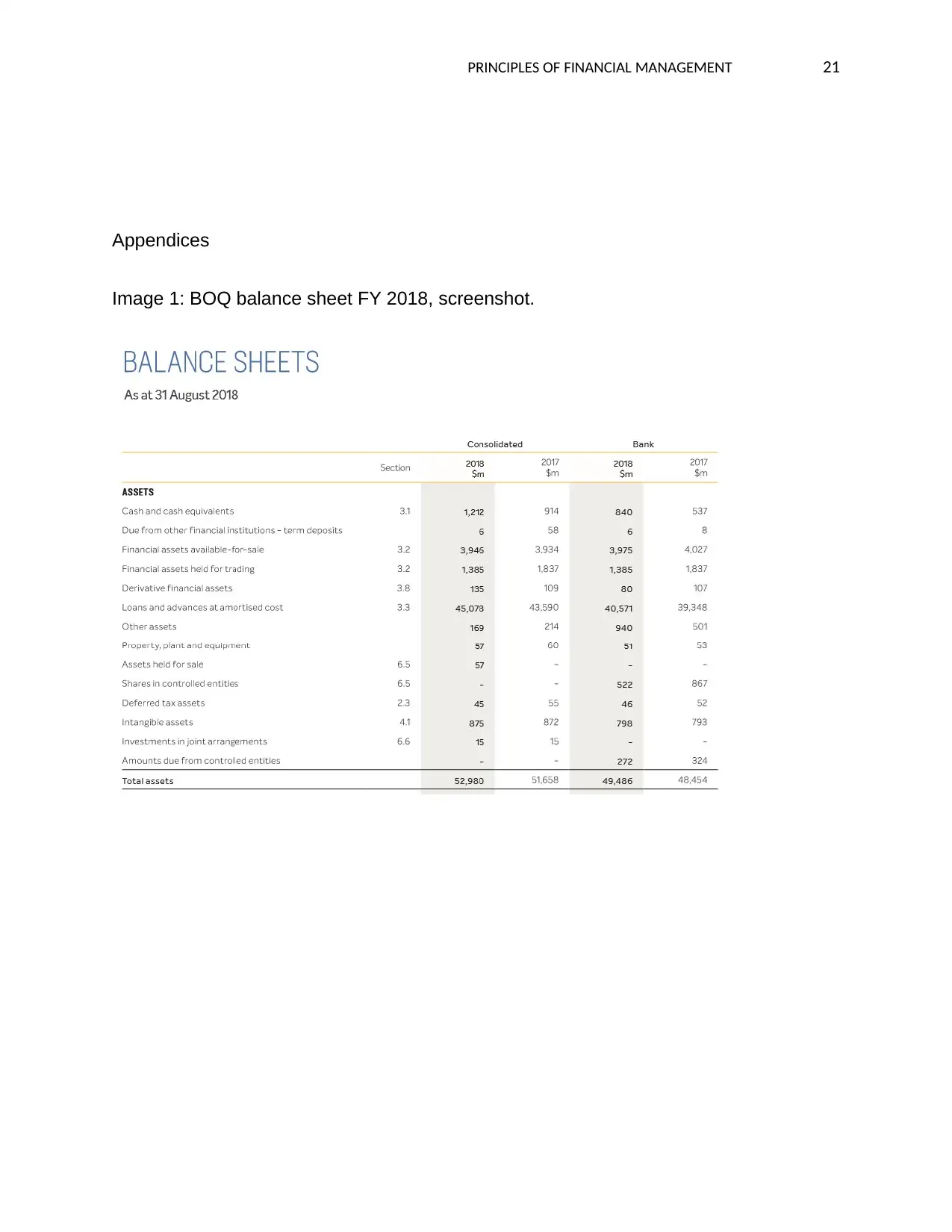
PRINCIPLES OF FINANCIAL MANAGEMENT 21
Appendices
Image 1: BOQ balance sheet FY 2018, screenshot.
Appendices
Image 1: BOQ balance sheet FY 2018, screenshot.
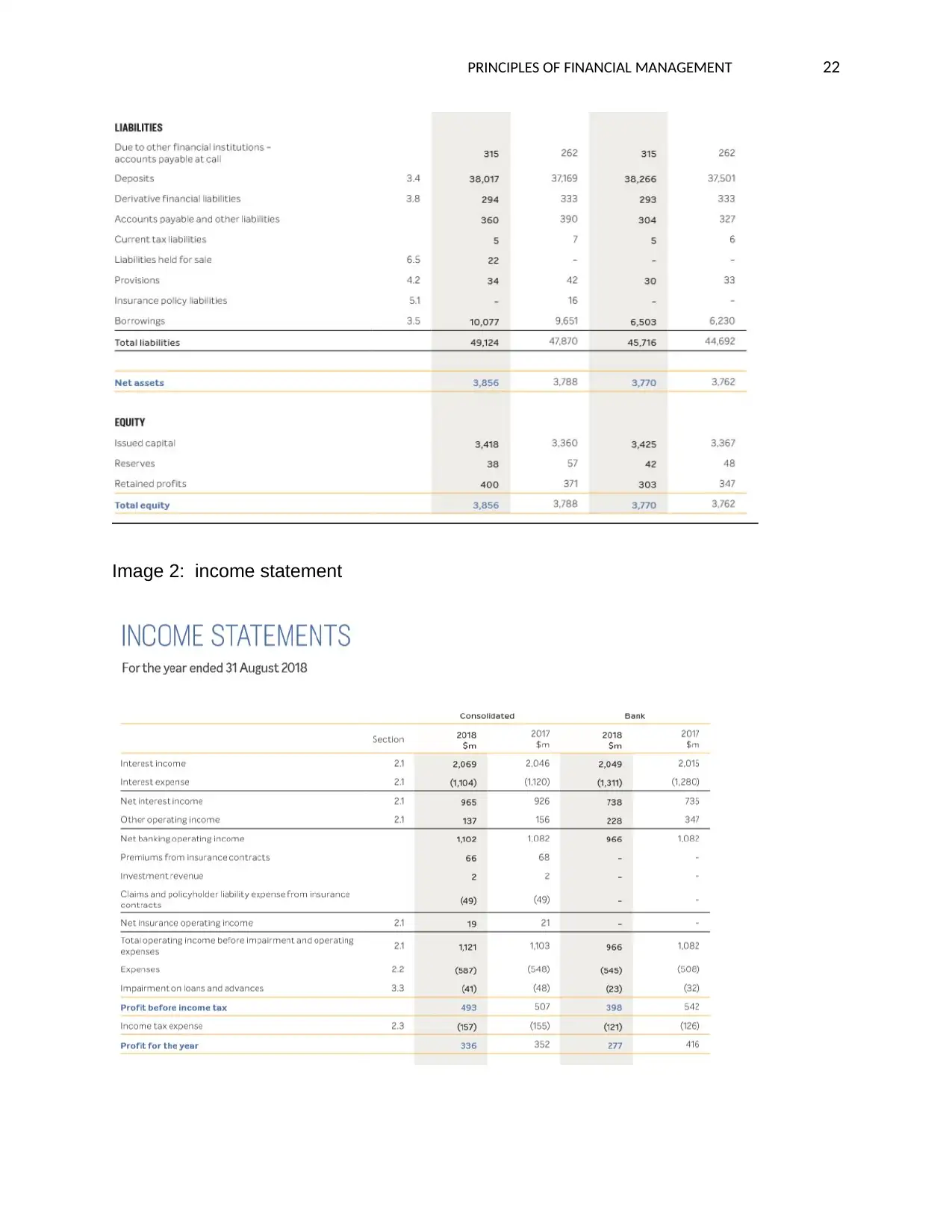
PRINCIPLES OF FINANCIAL MANAGEMENT 22
Image 2: income statement
Image 2: income statement
Secure Best Marks with AI Grader
Need help grading? Try our AI Grader for instant feedback on your assignments.
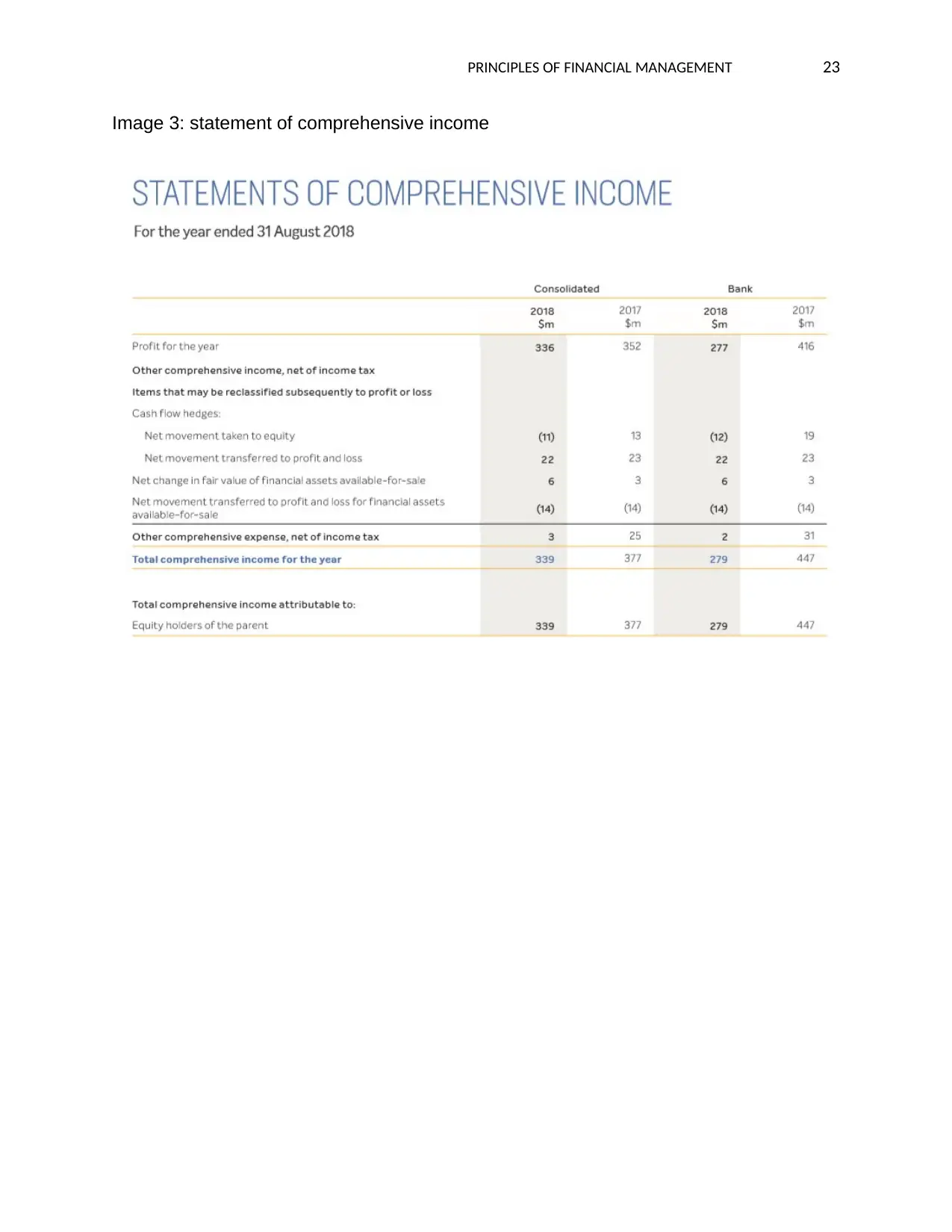
PRINCIPLES OF FINANCIAL MANAGEMENT 23
Image 3: statement of comprehensive income
Image 3: statement of comprehensive income

PRINCIPLES OF FINANCIAL MANAGEMENT 24
Image 4: statement of changes in equity
All images by: BOQ. Retrieved from
https://www.boq.com.au/content/dam/boq/files/shareholder-centre/financial-results/
2018/FY2018_Annual_Report.pdf
Image 4: statement of changes in equity
All images by: BOQ. Retrieved from
https://www.boq.com.au/content/dam/boq/files/shareholder-centre/financial-results/
2018/FY2018_Annual_Report.pdf
1 out of 24
Related Documents
Your All-in-One AI-Powered Toolkit for Academic Success.
+13062052269
info@desklib.com
Available 24*7 on WhatsApp / Email
![[object Object]](/_next/static/media/star-bottom.7253800d.svg)
Unlock your academic potential
© 2024 | Zucol Services PVT LTD | All rights reserved.





